The Best Sailboats for Rough Sea Conditions (13 Examples)
Are you planning to take on the challenge and sail in rough sea conditions? If so, you should equip yourself with the right sailboat that can handle heavy seas and keep you safe. Let's discuss the key features that make a sailboat ideal for rough seas and provide you with 13 examples of the best sailboats that you can consider for your next trip.
The best sailboats for rough seas have a strong and stable hull that can withstand the rough waves. They also have a deep keel that provides stability and prevents the boat from tipping over. Additionally, they have a spacious and comfortable cabin to enjoy a relaxing sailing experience even in rough conditions.
The Bermuda 40 is a good example of a classic sailboat that is known for its traditional design and seaworthiness. It has a full keel, which provides stability in rough seas. Let's look at more examples of sailboats that can handle rough sea conditions.
- The essential characteristics of an ideal sailboat for rough seas must include value for stability, comfort, speed, safety, and buoyancy.
- The best hull design type for sailboats in rough sea conditions is a deep-V hull or its modified version.
- The best rig type is either a cutter or a ketch, but for ease of handling, a sloop rig is best.
- A full-keeled sailboat is best in rough sea conditions because it provides excellent stability and directional control.
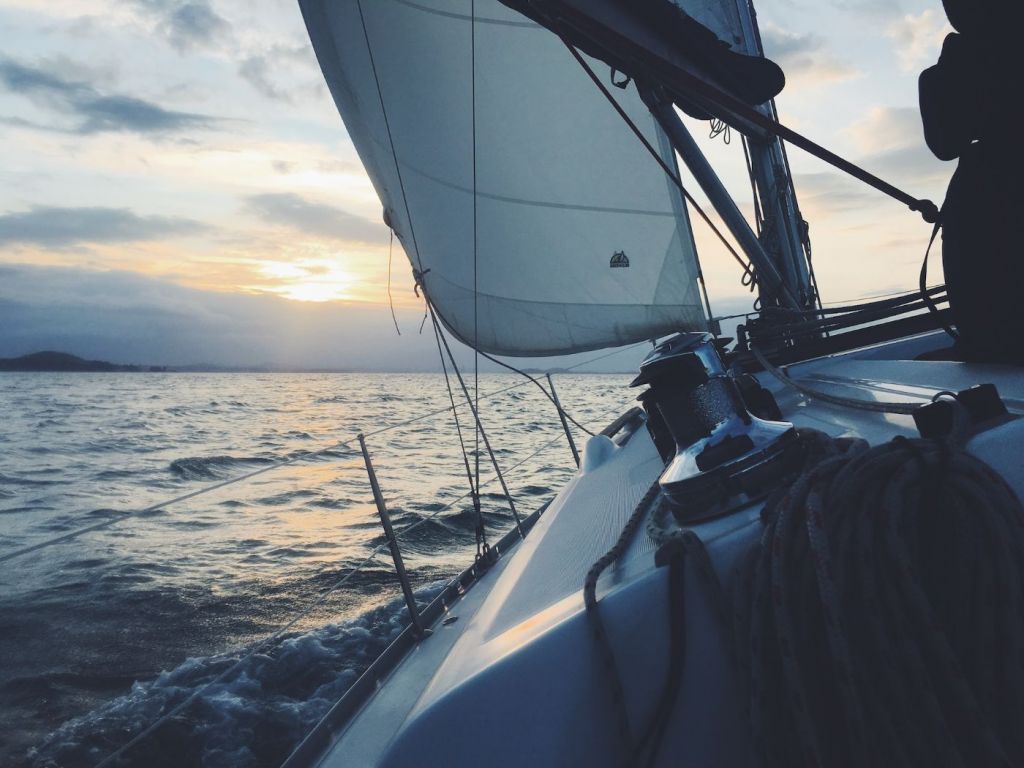

On this page:
13 examples of best sailboats for rough seas, key characteristics of sailboats for rough sea conditions, the best hull design and types for rough sea conditions, the best sailboat rig type for rough sea conditions, the most ideal keel type for sailboats in rough seas.
Here are 13 examples of sailboats for rough seas that you might want to consider:
| Twin-hull design provides excellent stability and reduces rolling in rough seas | |
| Narrow beam and heavy displacement make it very stable in heavy seas | |
| With a long keel for better directional stability during rough sea events | |
| Deep-V hull design and heavy displacement provide excellent stability and a smooth ride in rough seas | |
| Monohull sailboat with a fin keel for maneuverability in rough seas | |
| Heavy displacement and full keel provide excellent stability and tracking in rough seas | |
| Heavy displacement and centerboard keel provide excellent stability and tracking in rough seas | |
| Long keel and heavy displacement provide excellent stability and tracking in rough seas | |
| Has a fin keel for easy maneuverability in rough seas | |
| Heavy displacement and full keel provide excellent stability and tracking in rough seas | |
| Heavy displacement and full keel provide excellent stability and tracking in rough seas | |
| It has a fin keel that makes it easy to handle in heavy winds | |
| Deep-V hull design and heavy displacement provide excellent stability and a smooth ride in rough seas |
1. Prout Snowgoose 37: This is a real blue water cruising boat that is perfect for experienced multi-hull sailors who have cruised across the Atlantic. It is also a great option for those who are new to sailing on rough seas.
2. Moore 24: Designed by the legendary California sailor and surfer George Olson, the Moore 24 is one of the first ultra-light displacement sailboats. It is a fast, fun speedster that is perfect for downwind sailing.
3. Mariner 36: This is a classic cruising sailboat that is known for its durability and seaworthiness. It is equipped with a long keel which provides better directional stability than a similar boat with a fin keel.
4. Cal 34: This is a popular sailboat that is known for its performance in rough seas. It has a fin keel that makes it easy to handle in heavy winds.
5. Morgan 43: This is a monohull sailboat designed by Nelson Marek. It has a fin keel that provides maneuverability in rough seas.
6. Swan 43: This is a high-performance sailboat that is perfect for racing and cruising. It has a sleek design and a fixed, swept fin keel.
7. Bermuda 40: This is a classic sailboat that is known for its traditional design and seaworthiness. It is equipped with a centerboard keel, which is a pivoting lifting keel, allowing it to sail both coastal and inland waters.
8. Island Packet 26: This is a popular cruising monohull sailboat that is known for its spacious interior and comfortable ride. It has a long keel that provides stability in rough seas.
9. Mariner 47: This is a classic cruising sailboat that is known for its righting capability if capsized. It is equipped with a fin keel that provides splendid maneuverability.
10. LeComte Northeast 38: This is a classic sailboat that is known for its traditional design and seaworthiness. It has a full keel that provides stability in rough seas.
11. Westsail 32: This is a classic cruising sailboat that is known for its strength and durability. It has a full keel that provides stability in rough seas.
12. Dana 24: This is a popular cruising sailboat that is known for its performance in rough seas. It has a fin keel that makes it easy to handle in heavy winds.
13. J/35: This is a high-performance sailboat that is perfect for racing and cruising. It has a sleek design and a deep keel that provides stability in rough seas.
Now here are the essentials characteristics of the ideal sailboat for rough sea conditions:
- A sturdy and well-built hull that can withstand the impact of waves
- A deep keel that provides stability and prevents capsizing
- A strong and reliable rigging system that can handle high winds
- A well-designed deck that provides ample space for the crew to move around safely
- A comfortable and secured cockpit that keeps the crew protected from the elements
- A reliable engine that can be used in case of emergency
Rough sea conditions can be caused by a variety of factors, such as high winds, storms, and tides. High winds can create large waves that can be difficult to navigate, while storms can bring heavy rain, lightning, and unpredictable winds. Tides can also create rough seas, especially when they're opposing the wind direction.
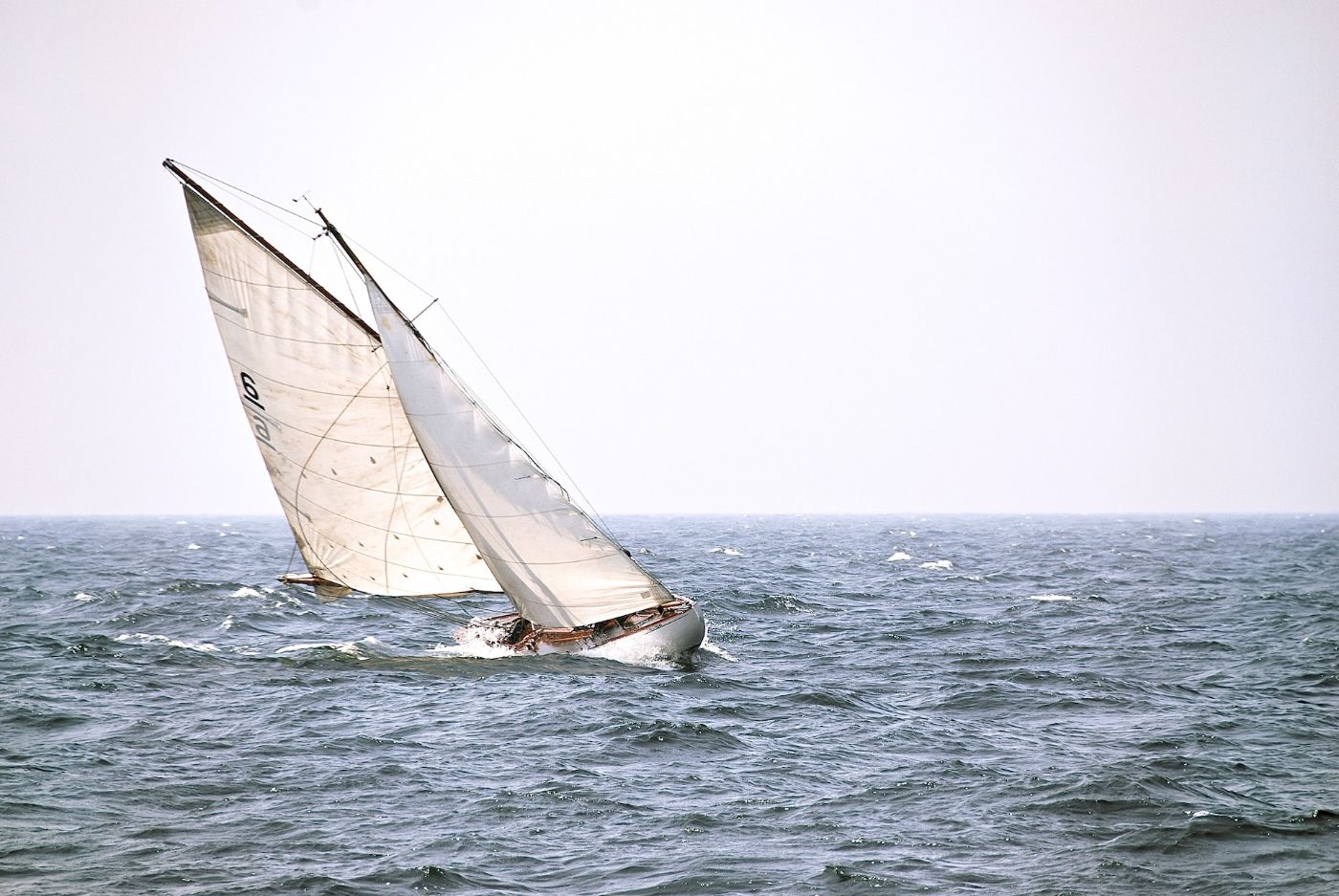
When sailing in rough seas, you might need to keep in mind that your sailboat will be subjected to constant motion , which can be uncomfortable and even dangerous if you're not prepared. Your sailboat must be able to handle the rough sea conditions and keep you safe.
The sailboat needs to be highly stable
A stable sailboat will be less likely to capsize or roll over in high waves. Look for sailboats with a low center of gravity and a wide beam ratio for added stability. Sailboats with a beam ratio of at least 3:1 have improved stability and comfort.
The boat must have essential safety features
You can check if the sailboat has adequate safety features, such as a sturdy hull, strong rigging, and proper safety equipment. Additionally, consider the sailboat's ability to self-right if it capsizes.
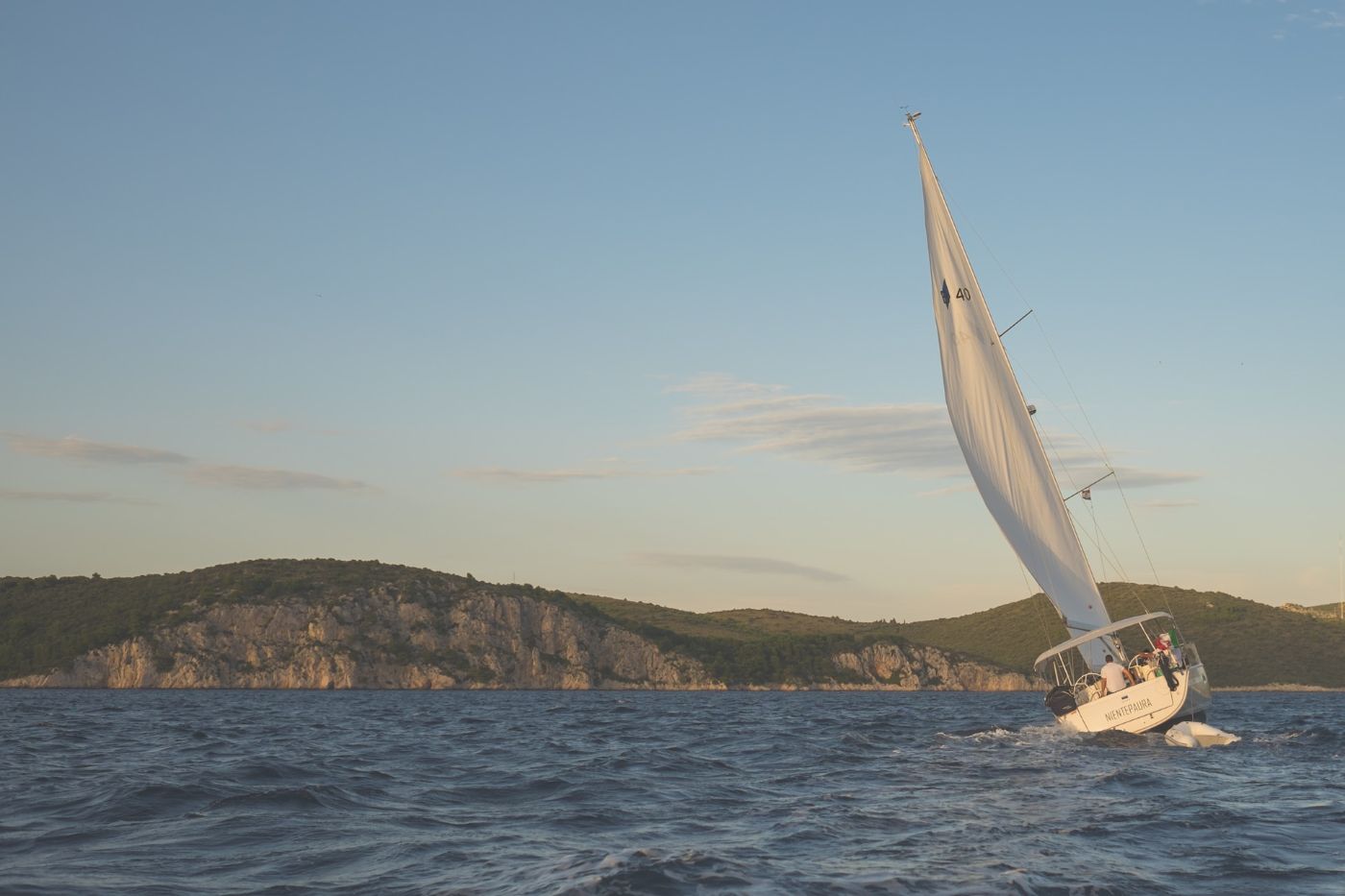
The sailboat must be comfortable enough
Some sailboats are designed to provide a smoother ride. Look for sailboats with a deep V-shaped hull and a high deadrise angle for improved comfort in choppy waters.
The deadrise angle is the angle between the hull and the waterline. A high deadrise angle can help a sailboat cut through waves more efficiently, providing a smoother ride in rough seas.
The boat must have improved speed when necessary
Speed is not always a top priority when sailing in rough seas, but it can be important in certain situations. For example, if you need to outrun a storm or reach a safe harbor quickly. Look for sailboats with a high buoyancy-to-weight ratio and a planing hull for improved speed in rough conditions.
The sailboat should stay afloat
Buoyancy is critical when sailing in rough seas. A sailboat with high buoyancy will be more likely to stay afloat in high waves. Look for sailboats with a displacement-to-length ratio of 100 or higher for improved buoyancy.
Here are different types of hull designs available, and each has its advantages and disadvantages:
| Single hull | Stable and maneuverable | Less stable in rough seas | |
| Two or more hulls | Greater stability and speed | Requires more maintenance | |
| V-shaped hull | Cuts through waves and provides a smooth ride in rough seas | Less stable in calm waters | |
| Slightly modified V-shaped hull | Offers good stability and maneuverability in rough seas | Less efficient at high speeds | |
| Flat bottomed hull | Good stability in calm waters | Less efficient and uncomfortable in rough seas | |
| Rounded hull | Good stability at high speeds | Less stable in rough seas | |
| Two parallel hulls connected by a deck | Stable and fast | Can be expensive | |
| Three hulls with the main hull in the center | Fast and stable | Can be difficult to maneuver in tight spaces |
The best hull design type for sailboats in rough sea conditions is a deep-V hull or a modified-V hull. These hull designs are able to cut through waves and provide a smooth ride, even in choppy waters.
They also offer good stability and maneuverability, which are important in rough seas. Other hull designs, such as catamarans and monohulls , are also effective in rough sea conditions. Catamarans have more roll stability, while monohulls are better at upwind sailing.
If you want a more detailed discussion on hull designs and types, you can try reading this article.
In this section, we will discuss the three most common rig types: Sloop, Ketch, and Cutter.
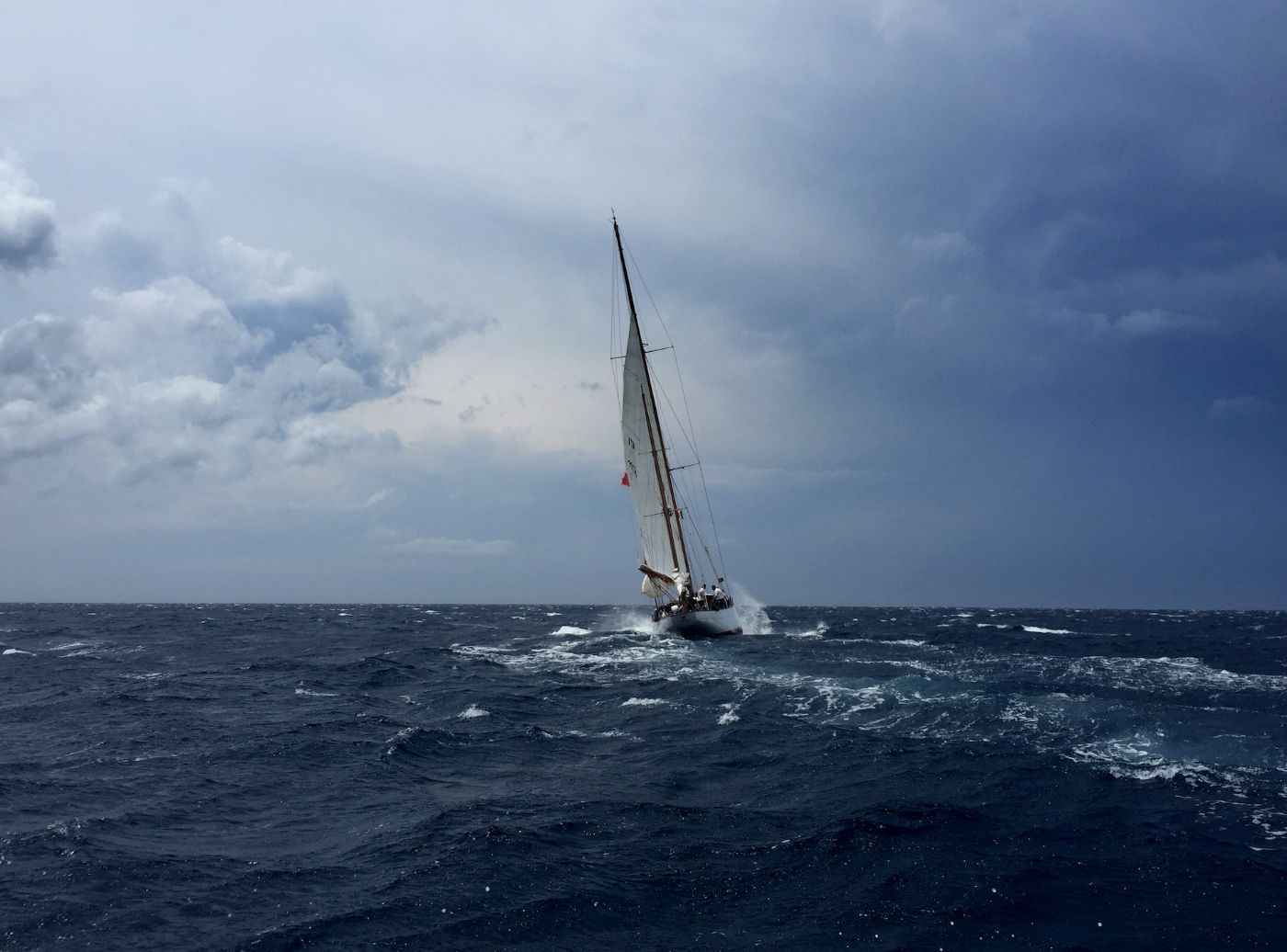
The sloop rig is the most common rig type
The sloop rig is often used on sailboats of all sizes. It consists of a single mast with a mainsail and a headsail. The mainsail is typically larger than the headsail, and the sail plan is designed to be easily managed by a small crew. The sloop rig is known for its simplicity and ease of handling, making it a popular choice for both cruising and racing.
Ketch is more advantageous in rough seas
The ketch rig is similar to the sloop rig, but it has two masts. The mainmast is taller than the mizzenmast, and both masts have their own sails. The mainsail is typically larger than the mizzen sail, and the mizzen sail is located aft of the cockpit.
The ketch rig is known for its versatility and ability to handle a variety of wind conditions. It also provides more sail area than a sloop rig, which can be advantageous in rough seas. However, they can be more complex to manage than a simple sloop rig and requires more crew members to handle the sails.
The cutter rig can sail upwind
The cutter rig is a type of rig that features a single mast with two headsails. The mainsail is typically smaller than the headsails, and the sail plan is designed to provide maximum power and speed in all wind conditions.
The cutter rig is known for its ability to sail upwind, making it a popular choice for offshore cruising and racing. It is also known for its stability in rough seas, as the multiple headsails provide more control over the boat's direction.
A more detailed discussion of different types of sail rigs can be found in this article.
The best keel type for sailboats in rough sea conditions is full keel because it provides excellent stability and directional control. It extends the length of the boat and is typically deeper than other keel types, providing a large surface area to counteract the force of the waves.

This design also helps to distribute the weight of the boat evenly, which reduces the risk of capsizing. It also provides a straighter and more predictable path through the water , which makes it easier to maintain course and avoid being pushed off course by waves.
This is particularly important in rough sea conditions where waves can be unpredictable and may come from multiple directions. Other keel types, such as fin keels or shoal draft keels, may be more suitable for calmer waters or shallow depths, but may not offer the same level of stability and control in rough sea conditions.
Leave a comment
You may also like, guide to understanding sail rig types (with pictures).
There are a lot of different sail rig types and it can be difficult to remember what's what. So I've come up with a system. Let me explain it in this article.
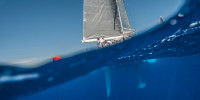
Sailboat Keel Types: Illustrated Guide (Bilge, Fin, Full)
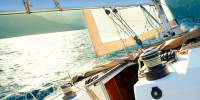
5 Surprising Advantages of a Full Keel Sailboat

The Illustrated Guide To Boat Hull Types (11 Examples)
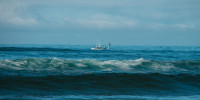
Here Are the Most Stable Boat Hull Designs (with Examples)
Yachting World
- Digital Edition

Video: 6 of the best heavy weather sailing videos
- Harriett Ferris
- June 18, 2017
Watch our pick of the most dramatic heavy weather videos

This first video of heavy weather sailing is our from our Storm Sailing Series with Skip Novak . It was probably the most ambitious project Yachting World has ever undertaken: to head for Cape Horn with high latitudes doyen Skip Novak to make a series on Storm Sailing Techniques . Here is one of our most popular videos, rounding Cape Horn in Storm Force 10 conditions…
Hallberg Rassy are known for being heavy, sturdy, seaworthy boats. This video shows Hallberg Rassy 48 Elysium in heavy weather off Cape Gris Nez, northern France in 2014. The yacht seems to be handling well, able to use a Raymarine lineair 7000 autopilot depsite the conditions.
This compilation is from the BT Global Challenge round the world race, a crewed race westabout the prevailing winds in one-design steel 72-footers. It took amateur crews upwind through the Southern Ocean from Cape Horn to New Zealand and from Australia to Cape Town. This footage shows some of the weather they experienced and what the crews endured – and watch out for some footage of the race leaders fighting it out under trysail during a severe storm in the Cook Strait in New Zealand.
Single-handed sailor Berthold Hinrichs sailing in Hinlopenstretet. It is the 150km long strait between Spitsbergen and Nordaustlandet in Svalbard, Norway and can be difficult to pass because of pack ice.
A fun compilation video of sailing in strong breeze including 2 wipeouts, 1 dismasting and 1 guy going for a swim…
Our last example comes from popular YouTube channel Sailing SV Delos , as the crew tackle a 50-knot gale on the crossing to Madagascar. Skip to 8:00 for the stormy stuff:
If you enjoyed this….
Yachting World is the foremost international magazine for bluewater cruisers and offshore sailors. Every month we have practical features to help you plan and prepare to realise your sailing dreams. Build your knowledge month by month with a subscription delivered to your door – and at a discount to the cover price. S ee our latest offers now.

10 Tips for Sailing In Heavy Weather

Last Updated by
Capt Chris German
June 15, 2022
They say that calm seas never made a great sailor. Rough seas and heavy wind are just a right of passage for many. I however would argue that the best sailors are those who manage to avoid heavy weather entirely.
Reading a weather report and planning one’s voyage to avoid nasty weather is the best call of them all. But, if you find yourself under gloomy skies and heavy chop unexpectedly, then getting yourself back to shore becomes paramount.
Here are a few tips for bad weather sailing that have helped salty sailors stay safe.
Table of contents
1. An ounce of prep saves a pound of trouble
Whether it’s replacing the impeller before it goes bad or coiling lines properly before you head out, preparation is the name of the game when it comes to sailboats. They say that the average sailor spends 10 hours working on a boat for every hour sailing and that’s just about how it should be. Making sure everything is working and properly cared for is a full time job and if you're not putting in the hours to keep your boat in tip top condition, your boat will fail you just when you need it most.
Things to watch out for when prepping for bad weather include:
- Scuppers are clean and free flowing. An errant acorn or a wad of tape can turn an otherwise seaworthy boat into a bathtub. Heavy rain and/or crashing waves have been known to sink a vessel that could not properly ship water overboard. Take the time to make sure your scuppers can save your boat and your life in heavy conditions.
- An orderly boat is a safe boat and that includes properly coiling lines. If you don’t know how to properly coil a line then you should learn asap. You never know when you will need to cast off a line or drop a sail in a hurry. Making sure that all your lines are properly coiled ensures that a line will run freely without kinks or “ass holes” when you need it to.
- Engine maintenance is all too often forgotten on sailboats. In heavy weather, bare poles are sometimes much safer than sails and a good working motor can be the difference between life and death. Changing the oil, checking belt tension and visually inspecting through hull fittings should be part of common practice on your boat. Having back up supplies like an impeller, hoses and belts are also part of good maintenance and you should regularly check your supplies and replace them when they get used.
2. Reef early, reef often
If you read last week’s piece on reefing , you may think I am beating a dead horse. But I can’t stress enough the importance of reefing in heavy weather. A better alternative to reefing is using the right sail for the right conditions. Many a genoa jib has been reduced to shreds in heavy air when a skipper fails to change sails in a timely manner.
Much like reefing, which should be done before you actually need to, so too should you raise your storm jib and douse your main before the heavy weather starts. Making the call to reduce sail or go bare poles can be a life saving call when made at the appropriate time. If you don't know how to reef or have difficulty changing sails, you should refrain from sailing in heavy air until you have had a chance to practice in lighter conditions.
3. File a float plan
In this day and age with cell phones and email, we often think help is just a text message away. At sea, especially in heavy air, sending a text message or making a phone call can be impossible.
Rain, wind and waves can kill a cell phone and if you doubt that, here’s a little virtual experience of sailing in heavy weather.
Put on all your foul weather gear, turn your shower on full blast cold and have your partner bring the garden hose into your bathroom. Then stand in the shower while your partner sprays you with the hose. For an even more real experience, crumple up $100 dollar bills and flush them down the toilet while you're at it. Then you will realize that using a cell phone in heavy weather is nearly impossible.
That is where the float plan comes into play. By leaving a detailed account of your planned voyage in writing with someone who cares about you, you will ensure that when you are late someone will miss you. And I can’t stress that you leave your float plan with someone who cares about you enough to miss you if you don’t show back up.
In the marina office where I currently work, one of our guests left a float plan with our staff saying that if they weren’t heard from by June 30th that we should send out a search and rescue mission. I found that note on the peg board in our office on July 22. I never heard if they made it back but didn’t see them on the news either so I am hoping they are safe.
But who knows, they may be stranded in the back of some canyon and 10 years from now we will hear about their amazing survival story.
4. Avoid glass and label your can goods
In rough seas, the galley becomes a battlefield. The pitch and yaw of rough seas and gusty winds can turn a dutch oven into a scud missile. Things like glass jars and wine glasses soon become shrapnel as objects fling themself out of cupboards and smash on bulkheads and cabin floors.
When I was buying my endeavour 42, I hired a delivery captain to fit out the boat and sail it from Tampa Bay to Marathon Florida. As part of his job, he needed to buy living supplies to stay on the boat for three weeks as we brought the boat north to Beaufort, NC.
He bought all sorts of cool things like new pots and pans and a full set of flatware. He also bought a very nice french press coffee pot with a tempered glass cylinder to maximize flavor and keep coffee steaming hot. That coffee pot cost me $50 and lasted barely a mile and half out of port when a wake launched that glass cylinder against the bulkhead. Glass is tough on a sailboat.
That being said, I do love storing dry goods in mason jars afloat. Sure they break often enough, but they are relatively cheap to replace and ensure a watertight seal for your flour, rice, beans, oats and other dry goods that go bad in salty places in plastic bags.
You can protect them in the cupboard with silicone webbing available at most big box stores and online megamarts. But who is really gonna indict Grandma’s go to for preserving peaches when all it costs you a $1 worth of oats when it crashes to the deck.
Another good alternative for heavy weather life aboard ship is can goods. They are battle tested and virtually impermeable, even when stored in dank old dark holds of a sailboat. The drawback with can goods is you have to open them to see what’s inside when the humidity and seawater peel off the labels and melt them into bilge sludge.
Do yourself a favor and label them before you put them in the galley locker. Three days at sea with water seeping into every uncaulked hole can make even the most astute seaside chef scratch their head when they pull an unmarked can from the hold. Is it creamed corn or is it canned peas? Do you want to have to open five different cans of food to find the canned tomatoes you were looking for? Label everything in advance with a good label maker .
5. Head lamps, batteries, and darkness
The first night you find yourself wedging your bags around your body to keep you in the bunk while you try to sleep, you will realize life aboard ship in foul weather is tough. And it becomes even tougher when the darkness sets in and you are trying to preserve night vision so the on duty crew can keep the boat upright while the winds and waves batter them on deck.
Headlamps and good batteries are a must. One hand is always for you and the other is always for the boat so if you have to carry a flashlight to empty your bladder on a pitching boat deck in the middle of the night, you will likely hurt yourself.
By strapping on a headlamp ( preferably one that has a night vision setting - you know the red light that is used on submarines in the movies), you will keep both hands free to move about the cabin and perform on deck functions. You will get so much use out of a headlamp on a boat that you ought to bring back up batteries for it and for any other battery operated things you might have like fans, radios and other items.
A darkened ship is a different world and to be safe at night especially when it is rough weather requires that everyone respect each other's night vision while underway. A good headlamp with lots of back up power will make your life so much better that you’ll want to go sailing sometime soon again, even if you step off the boat after this storm and say” I’m never doing this ever again.”
6. The ditch bag - your secret weapon
All cruisers who go off shore are familiar with the ditch bag. It’s usually a waterproof bag that holds your important papers, credit cards, passport, medication, cell phone and other important stuff you might need if the boat goes down. But you don't have to be on a cross Atlantic blue water adventure hailing a mayday to enjoy the benefits of a ditch bag. When the weather turns foul, a waterproof ditch bag is a great place to put all your important stuff to keep it from getting saturated.
The nice part about a personal ditch bag is you can put anything you want in it. It will be there if the boat goes down, but it will also be safe even if the boat doesn’t go down and it just gets soaked by an improperly dogged down hatch or porthole. There are all kinds of good ditch bags and ways to protect your stuff, but one I really like and I am happy to call my friends is UGO.
It’s a neoprene carrying case for your cell phone and keys, but now they have an even larger tablet version which can hold even more stuff. But what’s so great about a waterproof carrying case for your phone you ask? Well this one floats just in case your vee birth fills with water and all you stuff get saturated in a pile on the deck.
You can rest assured that your wallet, cell phone and keys will float at the top of the pile and stay safe and dry in a UGO dry pouch. To be totally clear, Mel and Vicky are really great friends of mine, but I would advocate for UGO even if I didn’t know them because it’s just such a cool idea. You can check them out at most of the boat shows to see these things in action or head over to their website .undefined
7. Reach out to someone - from the middle of nowhere
Since I'm talking about great ideas and better deals let me also introduce you to the newest deal in Satellite Phones.
For far too long, Sat phones have been the privilege of the well-to-do who were not so well connected. If you wanted to go where the wild things were, you had to give up your connection to civilization or pay $1000 for a sat phone.
Since moving to Utah, I have found out how hard it is to make a call when service is spotty and quite frankly if I had had one of these phones on a few of my deliveries offshore, I wouldn’t have had so many run ins with bad weather- more on that in the next section.
While a brand new sat phone with data will run you upwards of $2000, Amazon has a refurbished sat phone for just $200 and plans for just $90 per month for Global Star and Nexus Wireless. We found this to be quite affordable and provide us with a ton of peace of mind while we are either on a mountain top in Utah or 50 miles off the coast of Florida.
Now I am not saying this phone will allow me to live stream to Facebook from the middle of the Gulf of Mexico, but what it will do is allow me to stay connected with shore, get weather updates and ensure I can reach help if I ever need it.
A Sat Phone should be part of everyone’s heavy weather operational plan and if you have any questions about whether it’s right for sailing in heavy weather or not, I point your attention to SV Delos and their voyage to the Azores last year .
They posted a daily update with conditions and stories to their Facebook page and their huge following 1000 miles from the nearest cell tower and always stayed in touch. Now that there are affordable sat phone solutions and even more affordable plans with Nexus Wireless, no one should head offshore or into heavy weather without one.
8. Know your weather before it hits you
The biggest thing about heavy weather sailing is the heavy weather. If you can avoid the nasties then why don’t you?
There are lots of tricks to tell where the wind is going to go next, but the best bet for weather prognostication I have found is satellite weather from Sirius XM. It’s not that expensive and you do have to buy some gear for your boat, but once I was hooked up, I got live weather updates laid over my gps screen and live lightning and winds warnings too. It really changed my world and after my experience on a 36 lagoon off the coast of Florida, I will never sail without XM weather ever again.
We were sailing out of Tampa once again on our way to do a delivery to Beaufort. We had been out for a week and the winds were light and variable the whole time. This meant that we had to motor most of the way and that caused us to blow a gasket on our starboard motor just outside Port St. Lucie.
When we put in, and because most of the trip was hot and boring and now a motor was dead, most of my crew decided to fly home and that left me and my buddy Jay to take this boat the rest of the way back to North Carolina, on one motor.
We decided to go at 6pm on a Tuesday.
We sailed through the first night without incident and by the time the sun rose the next morning, the wind had freshened just a bit and we were making a cool 5 knots some twenty miles off Melbourne. By midday we had reached Daytona Beach and off in the distance we could see dark clouds building.
By 3pm, we found ourselves darting between downpours and lightning strikes but it was until we eyed St. Augustine that the roll cloud appeared. With no cell phone and no weather info, we decided to make a bee-line for St. Austine and hoped to make it inside before the roll cloud reached us. We didn’t make it.
I could see the wall of wind rolling towards us from at least 10 miles off. The calm blue green seas turned in foam streaked torrents as the 75 mile an hour breeze streaked towards us. I told Jay to take the helm and I darted up to the mast to drop the main. It came down with a loud thump into the stack pack and then I turned my interests to the roller furled jib.
We had noted that it was incredibly difficult to turn due to a worn out bearing in the base, but failed to fix it while we were in the safety of the Gulf. Now that we were on blue water and all hell was about to break loose I regretted that, as I struggled to furl the jib.
When I got the jib half way in, the wall of wind reached us. The catamaran leaned hard to starboard as the wind hit us broadside and I begged Jay to head the boat to wind. The one motor groaned under the load but begrudgingly turned the bows of the pontoons to wind and allowed the jib to whip violently in the vicious wind. Just then rain began falling like boxes of hand grenades being poured onto a dance floor and echoed through the deck of the limping boat.
The sky seemed to become night within seconds with only the lightning to light our way. In the flashes I could see what was left of the jib whipping the jib sheets into a 18 inch knot. When the wall of wind passed us, a steady 20 knots followed and stirred the Atlantic waters into a washing machine.
For 6 more hours we plodded our way into port and slammed the stricken vessel into the first open slip we could find and walked away. I called my wife when I finally got cell service again and she sounded terrified when she picked up. “MY GOD ARE YOU STILL ALIVE?” I laughed weakly and said “yes, why?”
She then told me that the storm was all over the news and that she had tried to warn me that I was sailing right into it. With no working phone and no early weather warning, I was a sitting duck and so was our boat.
Thankfully we made it to shore, but there but for the grace of God go I. I will never go to sea ever again without satellite weather and a satellite phone.
9. Know your limits
I’m not saying that I was not ready to handle a 36’ lagoon at sea when that roll cloud came through, but I can tell you I was ill prepared. Without the right gear including weather and phones, I should never have tried that. But now I know. And I still get caught by the weather every once and again.
I wish I could say it gets better and that it isn’t as scary the second or third time, but I’d be lying. Anytime you're in bad weather in a boat, a little piece of you should be terrified. If it isn’t then you don't have enough experience to be out there and should have headed home way before the grey clouds roll in.
And that’s it. Know what you know and don’t do things that you don’t know. If you have never sailed in 30 knots of wind, don't start sailing in 50 knots. Read the forecast and sail to your experience level and to the readiness level of your boat.
Lots of people ask, I have a 26’ sailboat, can I sail offshore? You sure as hell can but why would you want to? If you have to ask the question if you should, then assume you should not. Because the fact that you even asked is evidence that you don’t know. So don’t do what you don’t know.
And here’s the big finish!
10. Consider your guests
No one likes to be scared or nervous or feel ill or worst of all be cold and wet. If you boldly go out, your first consideration should always be the comfort of your family and guests. If the weather turns foul, odds are the seas will build, the temps will drop and winds will freshen.
These factors make an otherwise pleasant day on the water, very unpleasant. And while it may just get your juices flowing to have a boat healed 45 degrees and 35 knots whipping across your deck, there is a very good chance that not everyone would agree with you that that is ideal sailing conditions .
Condescending, domineering skippers often find themselves single handing their boats because no one wants to sail with them. If you get a reputation as a skipper who always finds the heavy breeze and the nasty conditions, you will soon be short of guests to sail with. So always check the weather and plan your trip with a top consideration for your guests.
So that's it, my ten best tips for sailing in heavy weather. I have spent more than my share of time sailing in weather I would rather not have sailed in and I like to think that I am old enough and smart enough to avoid the nasties whenever I can. I wish I could.
Mother Nature is a fickle old girl and can turn on a dime. Prep yourself and your boat for the nasties well in advance and never leave the dock without the assumption that bad weather could and will hit. If you get back to shore afterwards and all was fine then you lucked out. But don't ever rely on luck to keep you safe in a sailboat.
Thanks for reading, and remember to do good, have fun and sail far.
Related Articles
Capt Chris German is a life long sailor and licensed captain who has taught thousands to sail over the last 20 years. In 2007, he founded a US Sailing-based community sailing school in Bridgeport, CT for inner city youth and families. When Hurricane Sandy forced him to abandon those efforts, he moved to North Carolina where he set out to share this love for broadcasting and sailing with a growing web-based television audience through The Charted Life Television Network.
by this author
How to Sail
Emergencies

Most Recent

What Does "Sailing By The Lee" Mean?
Daniel Wade
October 3, 2023

The Best Sailing Schools And Programs: Reviews & Ratings
September 26, 2023
Important Legal Info
Lifeofsailing.com is a participant in the Amazon Services LLC Associates Program, an affiliate advertising program designed to provide a means for sites to earn advertising fees by advertising and linking to Amazon. This site also participates in other affiliate programs and is compensated for referring traffic and business to these companies.
Similar Posts

How To Choose The Right Sailing Instructor
August 16, 2023

How To Sail From California To Tahiti
July 4, 2023

How To Tow A Skier Behind A Boat
May 24, 2023
Popular Posts

Best Liveaboard Catamaran Sailboats
December 28, 2023

Can a Novice Sail Around the World?
Elizabeth O'Malley

4 Best Electric Outboard Motors

How Long Did It Take The Vikings To Sail To England?

10 Best Sailboat Brands (And Why)
December 20, 2023

7 Best Places To Liveaboard A Sailboat
Get the best sailing content.
Top Rated Posts
Lifeofsailing.com is a participant in the Amazon Services LLC Associates Program, an affiliate advertising program designed to provide a means for sites to earn advertising fees by advertising and linking to Amazon. This site also participates in other affiliate programs and is compensated for referring traffic and business to these companies. (866) 342-SAIL
© 2024 Life of Sailing Email: [email protected] Address: 11816 Inwood Rd #3024 Dallas, TX 75244 Disclaimer Privacy Policy
The Challenges of Sailing in Rough Seas: Tips and Strategies
Discover how to safely navigate through rough seas and overcome the challenges that come with sailing in unpredictable weather conditions.
Sailing in rough seas can be a daunting and challenging experience, even for the most seasoned sailors. The unpredictability of the ocean, combined with the potential for dangerous weather conditions, can make for a nerve-wracking journey. However, with the right preparation, knowledge, and mindset, you can overcome these challenges and safely navigate your way through rough waters. In this article, we will discuss some of the most common challenges faced by sailors in rough seas, as well as tips and strategies for overcoming them.
Understanding the Dangers of Rough Seas
Before we delve into specific tips and strategies, it’s important to understand the potential dangers that rough seas can present. Some of the most common hazards include:
- Large waves and swells, which can cause your boat to pitch and roll violently
- Strong winds, which can make it difficult to maintain control of your vessel
- Reduced visibility due to rain, fog, or spray from breaking waves
- Rapidly changing weather conditions, which can catch you off guard if you’re not prepared
- The risk of collision with other vessels, debris, or even land if you’re sailing close to shore
By being aware of these potential dangers, you can take steps to mitigate them and ensure the safety of your crew and vessel.
Preparing Your Boat for Rough Seas
One of the most important aspects of sailing in rough seas is ensuring that your boat is properly prepared for the conditions. Here are some tips for getting your vessel ready for a challenging journey:
1. Inspect and Maintain Your Rigging
Before setting sail, it’s crucial to thoroughly inspect your rigging and ensure that everything is in good working order. Check for any signs of wear or damage, such as frayed lines, corroded fittings, or cracked turnbuckles. Replace or repair any damaged components as needed, and make sure that all lines are properly tensioned.
2. Secure Loose Items
In rough seas, loose items can quickly become dangerous projectiles. Take the time to secure any loose gear, both on deck and below. This includes stowing away items like tools, dishes, and personal belongings, as well as securing larger items like dinghies, life rafts, and spare anchors.
3. Check Your Bilge Pumps and Through-Hulls
Make sure that your bilge pumps are functioning properly and that your through-hull fittings are in good condition. In rough seas, water ingress can be a major concern, so it’s important to ensure that your boat is watertight and able to effectively pump out any water that does make its way on board.
4. Prepare Your Crew
Ensure that your crew is well-rested, well-fed, and properly outfitted with appropriate foul weather gear. Discuss your plans and expectations for the journey, and make sure that everyone is familiar with their roles and responsibilities in rough conditions.
Strategies for Sailing in Rough Seas
Once your boat is properly prepared, it’s time to set sail. Here are some strategies for navigating rough seas safely and effectively:
1. Choose the Right Course and Speed
When sailing in rough seas, it’s important to choose a course and speed that will minimize the impact of the waves on your boat. This may involve altering your intended route or slowing down to reduce the risk of damage or injury. In general, it’s best to avoid sailing directly into or away from large waves, as this can cause your boat to pitch and roll excessively. Instead, try to maintain a course that allows you to ride the waves at an angle, which can help to smooth out the motion of your boat.
2. Use Your Sails Wisely
In strong winds and rough seas, it’s important to strike a balance between maintaining control of your boat and reducing the strain on your rigging. This may involve reefing your sails to reduce their surface area, or even switching to a smaller headsail or storm jib if conditions warrant it. Be prepared to make adjustments to your sail plan as conditions change, and always prioritize the safety of your crew and vessel over maintaining a fast pace.
3. Monitor the Weather
Keeping a close eye on the weather is crucial when sailing in rough seas. Make use of available weather forecasts and satellite imagery, and be prepared to adjust your plans if conditions deteriorate. If you’re caught in a storm, try to maintain a course that keeps you in the storm’s “navigable semicircle,” which is the area where the winds and seas are generally less severe.
4. Practice Good Seamanship
In rough seas, good seamanship is more important than ever. This includes maintaining a proper lookout, communicating effectively with your crew, and making smart decisions based on the conditions and capabilities of your boat. Remember that it’s always better to err on the side of caution and take a conservative approach to sailing in rough conditions.
Overcoming Fear and Anxiety
For many sailors, one of the biggest challenges of sailing in rough seas is overcoming the fear and anxiety that can accompany such conditions. Here are some tips for managing these emotions and maintaining a positive mindset:
1. Trust Your Boat
Remind yourself that your boat is designed to handle rough seas, and that it’s capable of keeping you safe as long as you take the proper precautions. Focus on the steps you’ve taken to prepare your boat for the conditions, and trust in its ability to carry you through.
2. Focus on the Task at Hand
When conditions are challenging, it’s important to stay focused on the task at hand and avoid becoming overwhelmed by the situation. Break tasks down into smaller, manageable steps, and concentrate on completing each one to the best of your ability.
3. Breathe and Stay Calm
In stressful situations, it’s easy to forget to breathe deeply and maintain a sense of calm. Practice taking slow, deep breaths, and remind yourself that you are capable of handling the challenges that lie ahead.
4. Learn from Your Experiences
Each time you sail in rough seas, you’ll gain valuable experience and knowledge that will help you become a more confident and capable sailor. Embrace these challenges as opportunities for growth, and remember that with each successful journey, you’re becoming better equipped to handle whatever the ocean throws your way.
Sailing in rough seas can be a challenging and intimidating experience, but with the right preparation, knowledge, and mindset, it’s possible to overcome these obstacles and safely navigate your way through even the most difficult conditions. By understanding the potential dangers, preparing your boat and crew, and employing smart sailing strategies, you can confidently face the challenges of rough seas and continue on your journey of exploration and adventure.

Techniques for Handling a Boat in Rough or Foul Weather
Sometimes the best way to deal with foul weather is to simply stay at the dock. Great advice, but what happens when you are boating and the seas turn with little notice? In this post we’ll explore some of the best practices with respect to boat handling in rough seas. You will gain familiarity with techniques for handling the various types of conditions you may encounter.*
Knowing what to do with the helm and throttle(s), combined with constant vigilance, are key to maintaining safe boating during inclement weather.
6 Types of Rough Seas
Here are six potential conditions you could encounter in rough seas:
- Head sea: A sea that is broad on the bow, coming at an angle between the bow and amidships.
- Broad sea: A sea coming at you between the bow and amidships.
- Beam sea: A sea coming at a right angle to the keel of your boat.
- Quartering sea: A sea coming at an angle between amidships and astern.
- Following sea: A sea coming directly on the transom.
- Chop or confused sea state: A combination of wind, waves and current produces a confused sea that seems to batter the boat from all directions at once.
Each of these conditions mentioned requires a different approach at the helm, and all can present some degree of danger if not handled properly. Being ready to immediately adjust your course and speed is critical in rough-water operations. Keep one hand on the helm and the other on the throttle in order to quickly maneuver in sea conditions that could be constantly changing.
In some cases it may be necessary to go as slowly as possible and still retain steerage. Keep a sharp lookout for other vessels. Visibility can be drastically reduced in rough seas whether from rain, fog or by the simple fact that with the waves and wave sets so high, you may find yourself in a trough every few moments thus reducing your visibility down to a couple hundred yards.
Although transiting directly into oncoming waves may provide the greatest amount of directional stability for your vessel, navigating into a head sea may not be the most comfortable course to steer due to the rapid pitching that occurs when you’re running directly into the waves, also referred to as taking the waves “on the nose.”
Comfort aside, heading into or slightly off the waves does provide the greatest margin of safety. The bow generates the least possible resistance to the waves and rudder effectiveness is maximized. Additionally, the waves are directly in front of you in a head sea, where they are easiest to read and anticipate. You may still have to reduce power on the downward slope to keep from burying your bow into the next wave. Try utilizing trim tabs to help avoid bow slam after cresting a wave.
When your course requires traveling in a beam sea, there are two options open to you. If the waves are broadly spaced, you may be able to stay your course and ride up and down them without excess rolling.
Otherwise, you can set a broad zigzag course, where you travel with the sea broad on the bow for some distance before turning 90 degrees and accepting a quartering sea for an equal distance. While neither leg may be particularly comfortable, such a strategy will reduce the danger that some beam seas can present.
Quartering Sea
Handling a quartering sea can be difficult and uncomfortable because it not only causes rolling and yawing but affects steering as well. Using a zigzag course may not be very inviting because you would end up alternating between a beam sea and a following sea during every cycle.
The alternative is a combination of wrestling with the rudder to keep the boat under control and delivering enough power to the prop to maintain speed while simultaneously keeping the waves from pushing the stern sideways as this can lead to broaching or capsizing in the trough of a wave.
Following Sea
With respect to following seas, there are many different elements that determine how a following sea will affect you and the amount of effort you will have to exert to avoid problems. The type of boat that may be in most danger in a following sea may be an outboard-powered boat with a low or cutaway transom. The combination of the aft weight of its propulsion and the absence of a barrier to oncoming water make it susceptible to swamping where the water rushes in from astern.
Following seas can propel the boat down the far side of a wave fast enough to bury its bow in the trough or they may push the stern sideways on the way down, causing the boat to broach. This can happen very quickly and has caught many skippers off guard.
In large, steep seas usually found in open waters, you will find yourself increasing power as you labor up the backside of a wave or swell and having to throttle back to control excess speed on the way down the other side to avoid burying the bow. The tricky part is to avoid slowing to the point where you lose steerage and the sea can push the stern aside. If you sense that happening, immediately steer in the direction the stern is being pushed and apply as much power as necessary to quickly maneuver back to your original intended heading. make sure trim tabs are up and engines are slightly out to help keep the bow from submarining.
In an extreme situation, such as navigating high waves that are rolling over the bar of an inlet, the best course is to work the throttle carefully so that you maintain a position just behind the crest and ride it in until you reach calmer water.
Chop/Confused Sea
Now let’s discuss chop, otherwise known as a “confused sea state”. Larger boats usually are unaffected by chop, and most smaller craft can handle it easily to a point. However, when opposing wind, tide and current combine into a sea of confused 3- or 4-foot waves, piloting the smaller boat will require close attention.
There is no specific way to handle such a situation. The best practice here is to simply reduce speed and maintain a good lookout. Deal with the oncoming waves that are the most precarious. This slow approach will allow you to steer into each peak or trough individually to keep the boat under control. The situation will make it difficult to maintain a course exactly, so keep an eye on your heading and position as you go.
Navigating in rough seas is a skill that must be learned through experience. Conditions vary greatly, and every boat responds with its own handling characteristics.
Maintaining your boat in good shape, knowing how to rig it for foul weather, and having a plan in place will go a long way to ensuring your safety.
* Yachts360 strongly advises against boating during adverse weather conditions and this post is for general information only, not a guide and therefore Yachts360 holds no liability. Use extreme caution and good judgement before each and every boating session.
- 2024 BOAT BUYERS GUIDE
- Email Newsletters
- Boat of the Year
- 2024 Freshwater Boat and Gear Buyers Guide
- 2024 Boat Buyers Guide
- 2024 Water Sports Boat Buyers Guide
- 2024 Pontoon Boat Buyers Guide
- Cruising Boats
- Pontoon Boats
- Fishing Boats
- Personal Watercraft
- Water Sports
- Boat Walkthroughs
- What To Look For
- Watersports Favorites Spring 2022
- Boating Lab
- Boating Safety
- Ultimate Boat Giveaway

The Best-Riding Center Console Boats for Rough Water
- By Heather Steinberger
- Updated: April 7, 2020
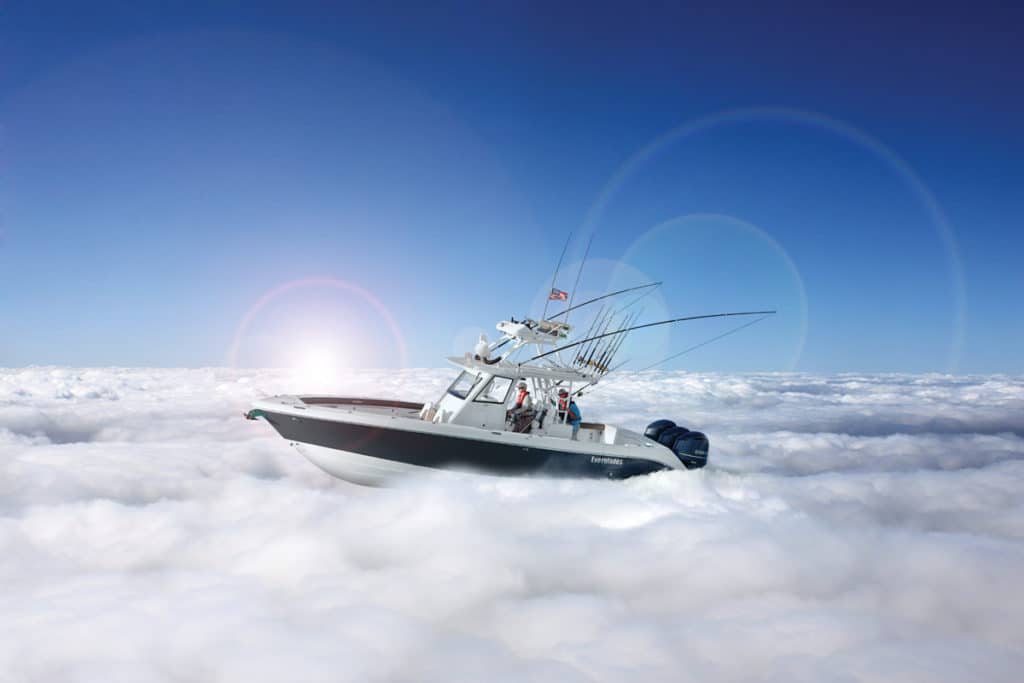
We’ve all been there. A headwind pipes up, and choppy, rough seas dance between you and your destination. You throttle up; you throttle back. You try to help your boat find its comfort zone, and you do your best to quarter the waves.
Inevitably, though, there are those stomach-dropping lurches and the slamming that clenches your muscles and rattles your dental work. Despite your best efforts, you can’t ignore the bangs down below, the ones that make the hull shudder. The ones that make you fervently hope that everyone involved with building this boat did a good job.
That’s a rough ride, even for a rough water boat. And it has happened to all of us, so let’s be honest. Not every boat can provide a soft, smooth ride in snotty conditions, no matter what the glossy brochures say.
We asked three prominent boat designers, and their answers provided much food for thought — regarding how to choose a vessel that’s going to provide a smooth ride, best boat for rough seas, the compromises and trade-offs inherent in your choice, and whether a smooth ride is even what you should be looking for in the first place.
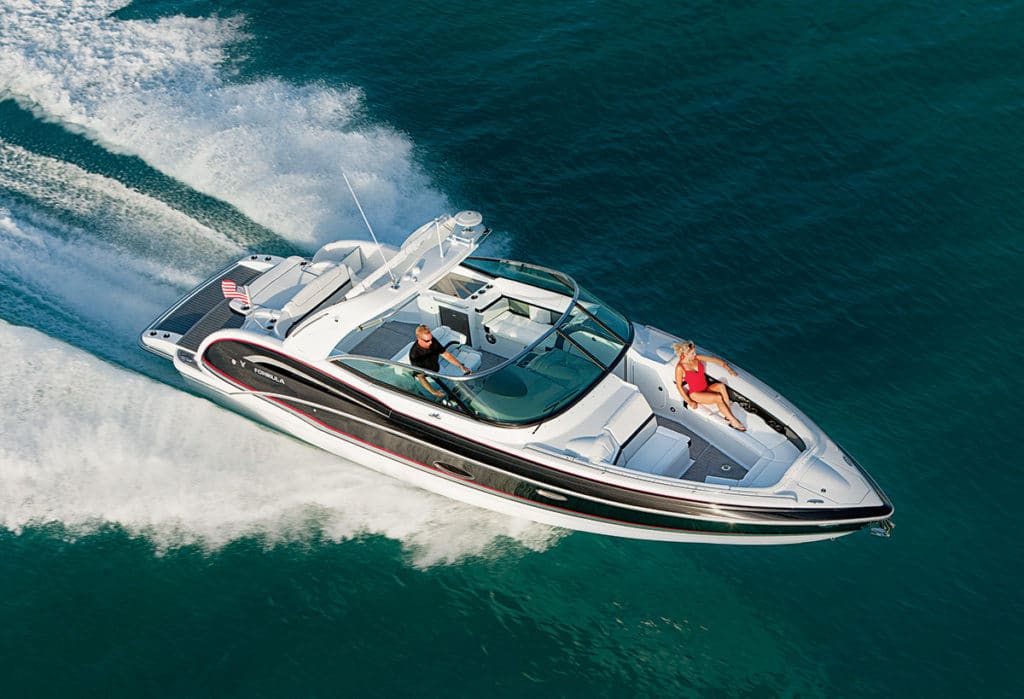
Comparing Displacement and Planing Boat Hulls
Dave Gerr founded New York City-based Gerr Marine Inc. in 1983. He’s designed a broad range of recreational boats and commercial vessels, both monohull and multihull. When it comes to designing a soft-riding hull, he immediately pointed out that there are different sets of criteria for displacement hulls and planing hulls.
Displacement hulls, he noted, don’t pound the way a planing hull will, so they automatically provide a softer ride. To maximize this, designers need to ensure three things: a good roll time, good heave characteristics and deadrise forward.
“For the roll time, we have a formula,” Gerr said. “Every boat has a natural roll period, which is 1 to 1.1 seconds times the boat’s beam in meters. If it’s slower than that, you’ll get that drunken motion. If it’s faster, it’s going to feel snappy and uncomfortable.”
For example, a boat with a 6.7-foot beam ideally should have an approximately two-second roll time. And, Gerr added, a reasonable deadrise forward will make the vessel even more comfortable.
The formula for heave, however, is more complicated. It involves the weight of the boat and the water plane area. The lighter the boat is, and the greater its water plane area, the greater the heave motion will be.
“A wide boat with a large water plane will bounce up and down violently,” Gerr said, “but if you have a small water plane compared to the boat’s weight, that heave will be slow. If it heaves too slowly, you’ve got a wet boat.
“You want to have your roll time and heave in the target region, and then add that deadrise forward,” he continued, “so you won’t have pounding in chop.”
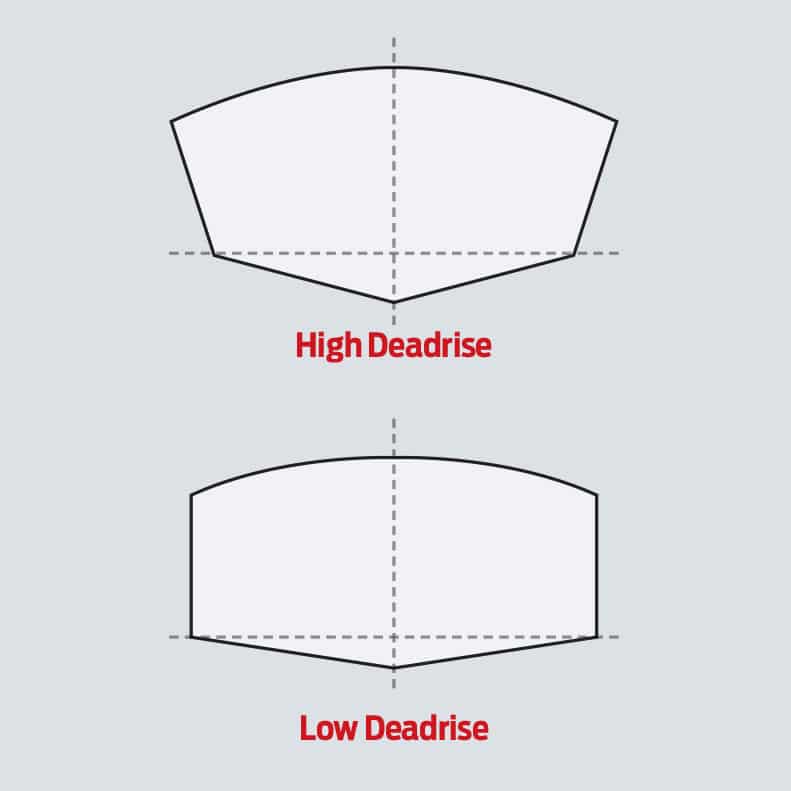
For a planing hull this is hard to achieve. By nature, these hulls are snappy and heave more while trolling or drifting; planing cancels that out, but you can still pound.
“What you really want is more deadrise,” Gerr said. “Just remember: The greater the deadrise, the slower the boat [for the same weight and engine]. That deep-V hull is going to need more power.”
A designer, he said, has to juggle power and what is good deadrise on a boat for optimum comfort.
“You put a deep, high deadrise at the forefoot to get the boat to lift its bow out of the water, or you’ll have steering problems,” he said. “You design it so it planes higher, and then you control it with trim tabs so you won’t trip over that forefoot.”
Deadrise is a difficult thing to visually assess at a boat show or in a dealer’s showroom, so how can a boater ascertain if a soft ride was a design priority? Gerr said the length-to-beam ratio is a dead giveaway.
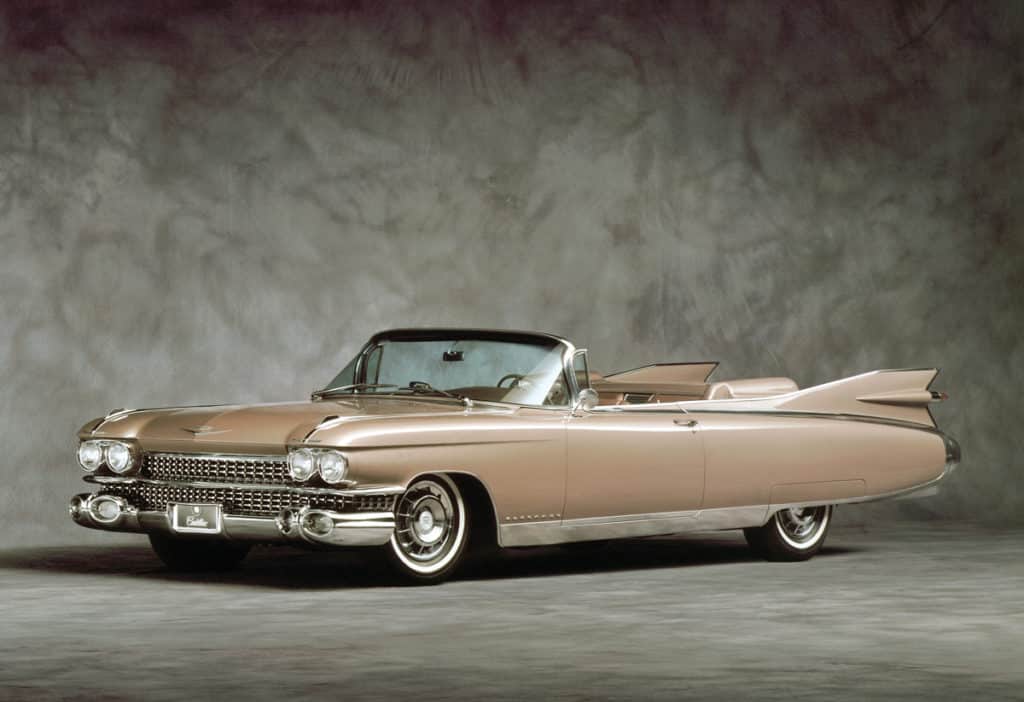
“A long, slender hull is going to have a softer ride, as long as the designer got the roll time right,” he stated. “A wide, shallow hull isn’t going to perform as well. And if you’ve got a high superstructure, you’re going to have increased roll and handling problems.”
Of course, less displacement means it’s a smaller boat inside. You’re going to have to go longer to get the same live-aboard space as that shorter, wider, taller boat next door, but the good news is that your boat is going to be faster and more fuel-efficient than the fat, high version of the same length.
If you are talking deadrise, Gerr said he likes to see a minimum of 17 degrees for offshore boats, although he observed that’s still a bit shallow. Deep-V hulls are considered to be 21 degrees or more. Consider this if you’re looking for the best deadrise for rough water.
“I’d say look for a deadrise of more than 20 degrees,” he advised, “and a length-to-beam ratio on the waterline that is greater than 3.5 to 1. Those two characteristics give you a pretty good idea that the design is intended for a soft ride.”
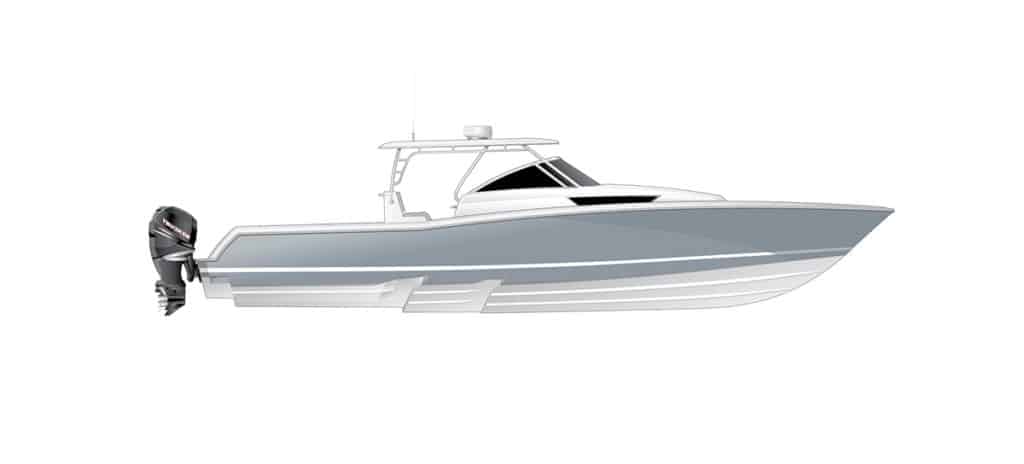

How Does a Boat Hull Handle in Following Seas?
Michael Peters founded Sarasota, Florida-based Michael Peters Yacht Design (MPYD) in 1981. Originally specializing in high-speed boats and offshore racing, MPYD now brings its fusion of performance and aesthetic standards to a wide variety of boat designs. When asked about the search for the perfect soft-riding boat, Peters laughed.
“Think of these ideals: soft-riding, dry and fast,” he said. “Now, pick two.”
The softer-riding a boat is, the wetter it is, because it doesn’t confront the wave. Rather, it splits it. If you want to knock the water down and push it away, then you’ll feel the impact. Boaters clearly need to consider these trade-offs when seeking a soft-riding vessel, but Peters has a more important cautionary tale to share. It’s natural to think of head seas and a soft-riding hull together in the same scenario — but what happens when the boat turns around?
“That’s a different story,” Peters said. “Following seas can pick up the stern, and the sharp angle and deadrise can cause the boat to bow-steer and broach. That’s a much more dangerous situation. It’s uncomfortable to hit the seas on the nose, but it won’t kill you. Boats go out of control in following seas, not head seas.”
Simply put, a hull that is too pointy forward and too flat aft will have an increased risk of broaching. Boaters should look for a hull with deadrise spread evenly — no extremes, such as a professional offshore racing boat’s sharp deadrise throughout the hull. The best boat hull for rough seas must be able to handle following seas.
“If you’re going to have fine forward sections, you’ll balance the hull by putting a lot of deadrise aft,” Peters explained. “You’re looking for recovery, a bow that doesn’t plunge and that can regain its buoyancy in a following sea.
“In our forward sections, we always run a convex section that’s puffed out,” he continued. “Some curvature helps dissipate wave energy and impact. Concave sections look like they’ll provide a softer ride, but they actually focus the energy.”
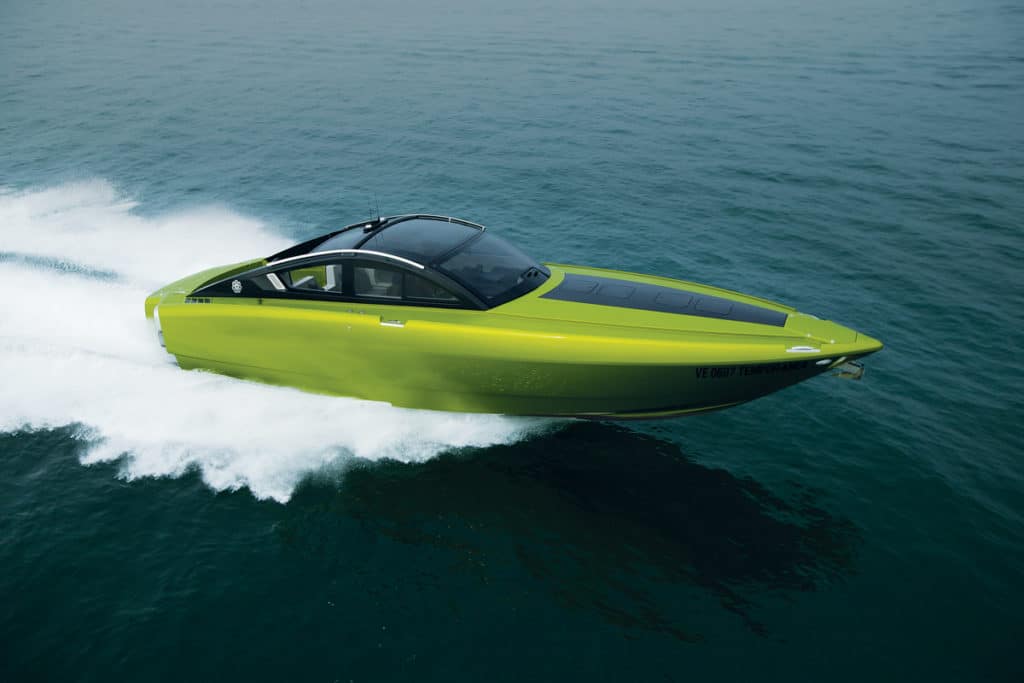
Peters’ advice to boaters is twofold. First, avoid those extremes. They’re not necessary for most recreational boaters. And second, make sure you have a good grasp of where and how you’re going to use the boat. An offshore cruising boat might not be the best choice for a river or inland lake.
“Lakes can be much harder for running a boat than the ocean, where you have long swells rather than steep, breaking seas,” Peters said. “Just make sure you’ve planned for the worst conditions you’ll run in, not the best, and never, ever sign a contract without running the boat in the intended conditions.”
Some boats, he said, are not designed to be the best boat . Sometimes the goal is to provide the best accommodations for the hull’s length and beam, which can mean creating a vessel that has a lot of windage, high freeboard, a high center of gravity and a very wide beam for its length.
“We don’t get to design the best boat in all cases,” Peters said. “No perfect boat? No kidding. But every boat appeals to somebody. One guy might love this particular boat, and he wants that 6-foot-4-inch headroom, while another guy is going to hate the compromises.”
“You always have to be aware that the more you emphasize space, the less boat it’s going to be,” he warned. “And it’s counterintuitive, but what looks good might not be good at all.”
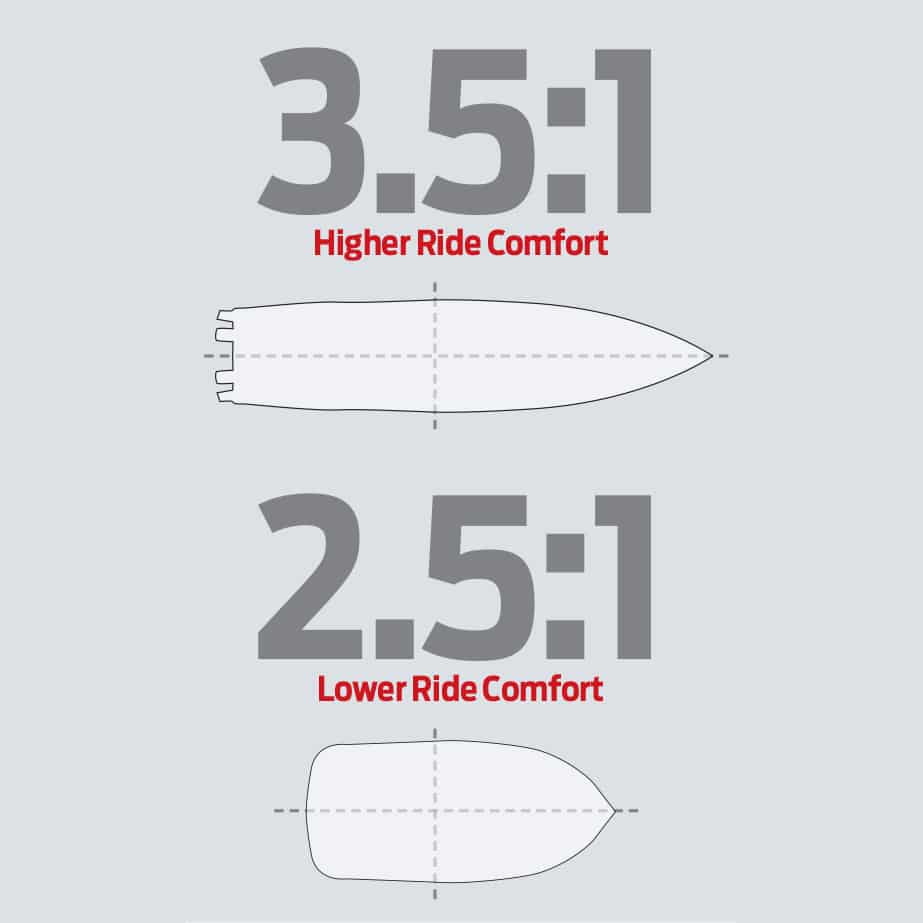
Peters also advised inquiring about a preferred design’s origins. Was it designed in-house at the boatbuilding facility? Was it designed by a naval architect? What are his or her credentials?
“Some people might not care, but it will help you better understand the design,” he said. “With a car, we accept that all the engineering is done correctly, and we can choose our favorite based on appeal alone. With a boat, you should think about engineering and stability calculations, not just styling.”
Finally, Peters noted that good hull designs stand the test of time. With most major advancements taking place in hybrids, like stepped hulls and multihulls, the average boat owner is going to be looking at hull designs that haven’t changed much in 20 or 30 years. And that’s OK.
“Most people just want a good family boat,” he said. “I’d say stay in the middle. The hull should look familiar. That hull from 30 years ago is still a good hull.”
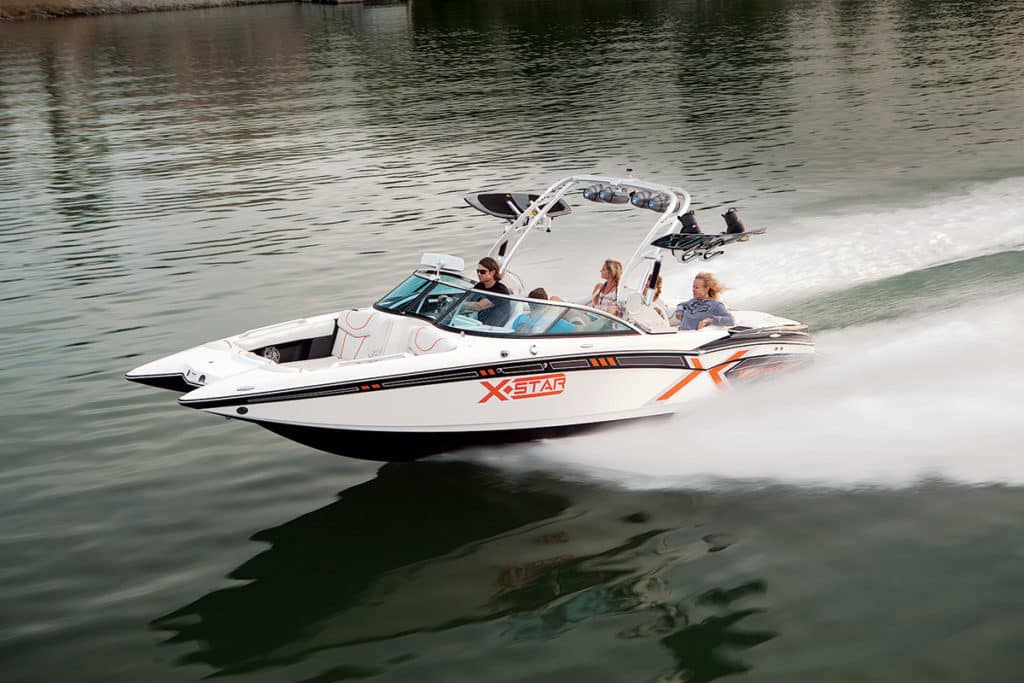
A Boat’s Soft Ride is Subjective
Peter Granata, owner of Palmetto Bluff, South Carolina-based Granata Design , has been designing boats since the early 1970s. With a number of award-winning designs and patented ideas under his belt, he’s firm in his conviction that the soft-ride discussion really shouldn’t be about the boat. It’s about the people involved.
“First of all, the hull ride is felt rather than measured,” he said. “And, it’s based very much on your own individual perception of what the boat looks like and what you expect it to deliver, plus your experience up to that point. It’s very subjective.”
Soft can be a relative term. A boater who is downsizing from a 60-foot yacht to a 30-foot pocket cruiser might find the smaller boat has the worst ride he’s experienced to date, whereas a boater jumping up from a 16-footer will say that 30-footer provides the best ride he’s ever had.
The most important questions a boater can ask, Granata said, are: How well does this design meet its intended purpose, and what can it do for me?
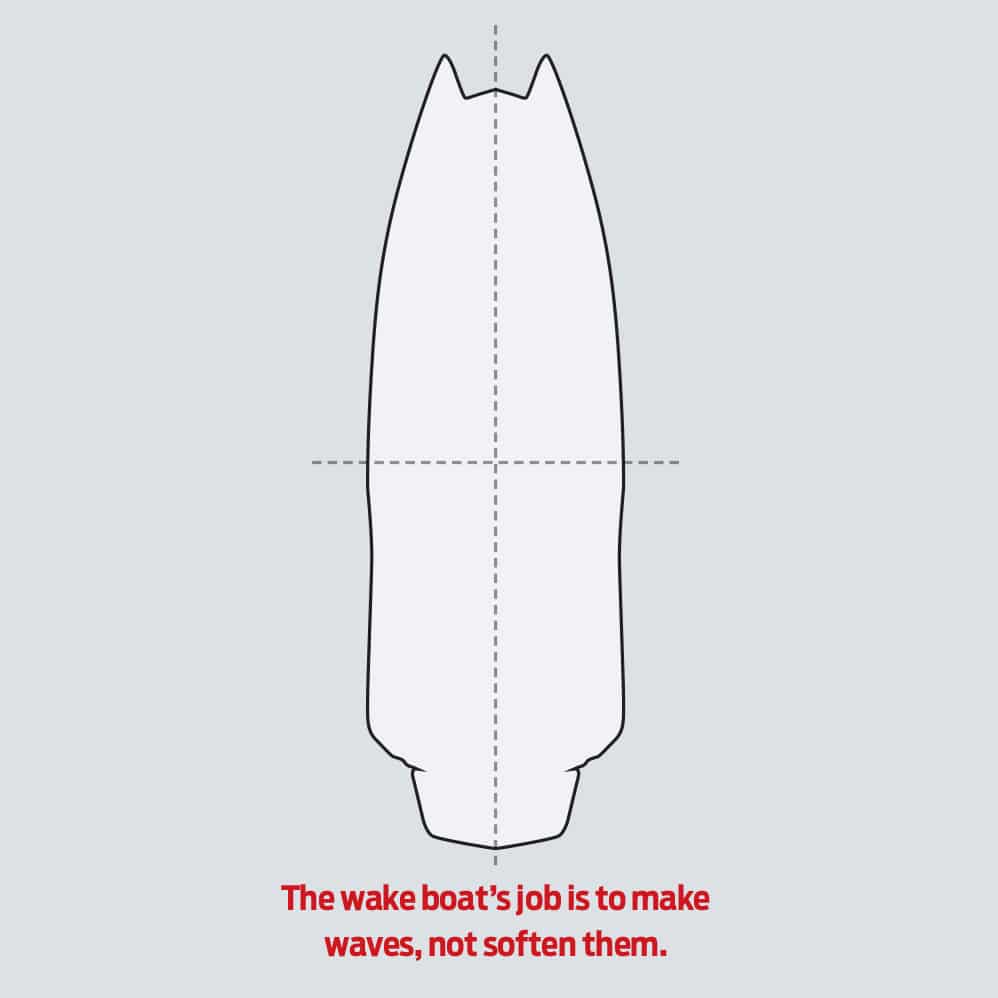
He provided a wakeboard boat as an example. The expectation is for thrills, not the softness of the ride.
“Soft ride is certainly a measurement when it comes to boat design, but it’s not the only one,” he said. “A designer should manage the ride aspect to meet the customer’s expectation. Does the boat do what it’s intended to do?”
The idea is that ride is less important than function, based on customer priorities. If you’re headed offshore and a dry ride is your No. 1 priority, you’ll want to make sure the hull has enough flare to ensure that the water follows the hull and travels outboard rather than over the deck. If you’re an angler, you might look for hull cutaways in the right spots to support the design’s self-bailing characteristics. Bass anglers seek extra buoyancy forward to support their weight.
With “dockominiums,” deep deadrise is unnecessary because owners place a higher priority on stability at rest, accommodations and space for entertaining. And with water-sports boats, the wake is all-important. Without that, the hull is worthless.
“We get so wrapped up in the specifics of hull generation that we forget someone has to buy it and spend time in it,” Granata said. “A designer has to know how the boat will be used, and you do as well. The boat is for you, not for the guy who made it.”
- More: boat building , Boats , Center Consoles
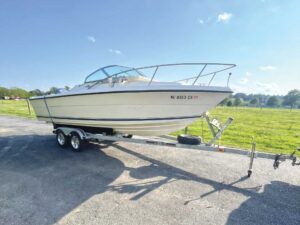
Is Your Trailer Right for Your Boat?
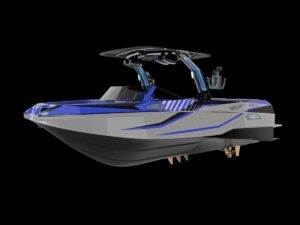
Genesis Marine Technologies 24: Our First Impression
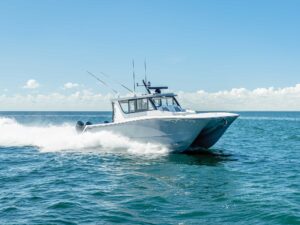
Five of the Top Power Catamarans
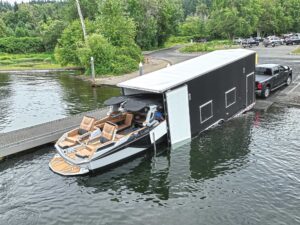
The Boat Trailer of Tomorrow
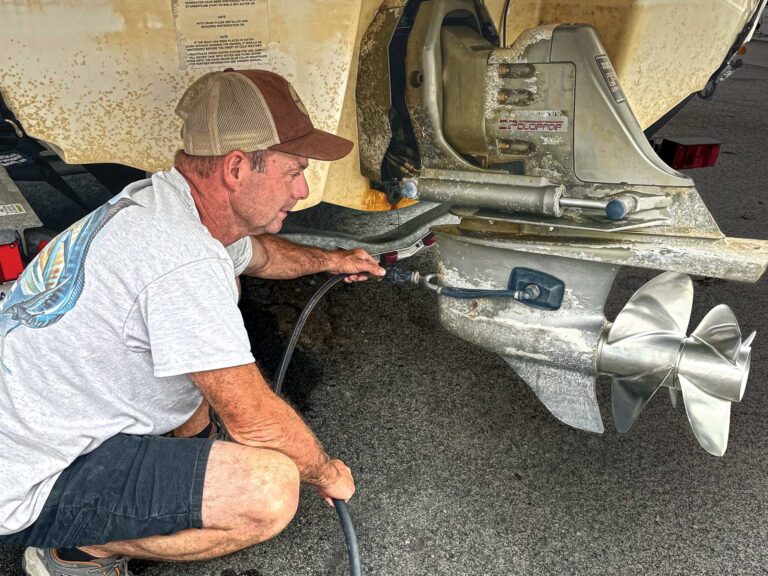
Midseason Sterndrive Maintenance
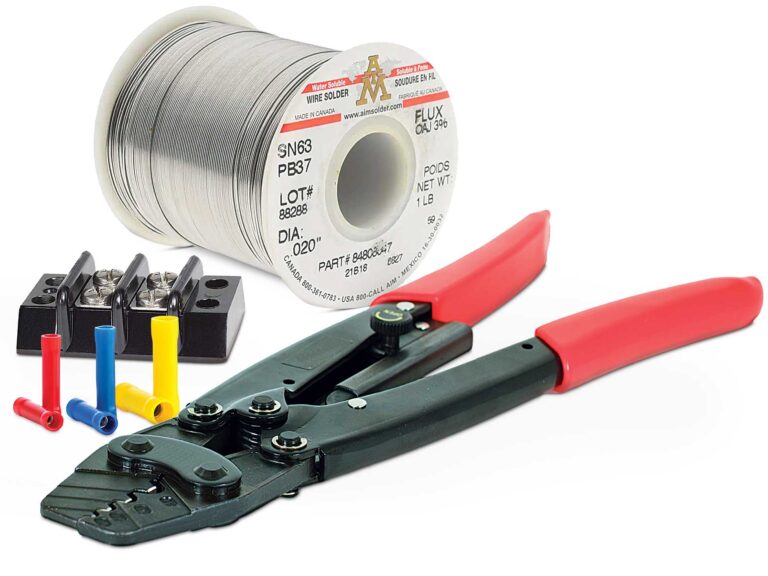
How to Properly Splice Wires on Your Boat
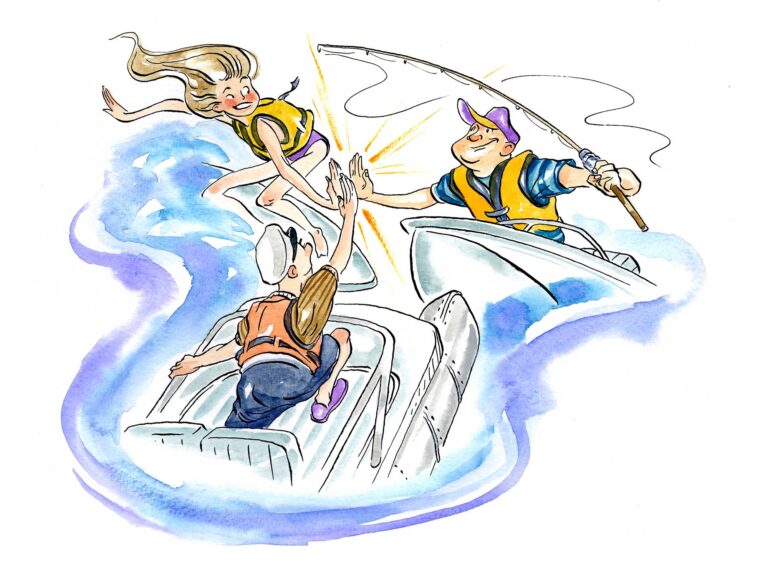
Sharing the Lake With Wakeboaters
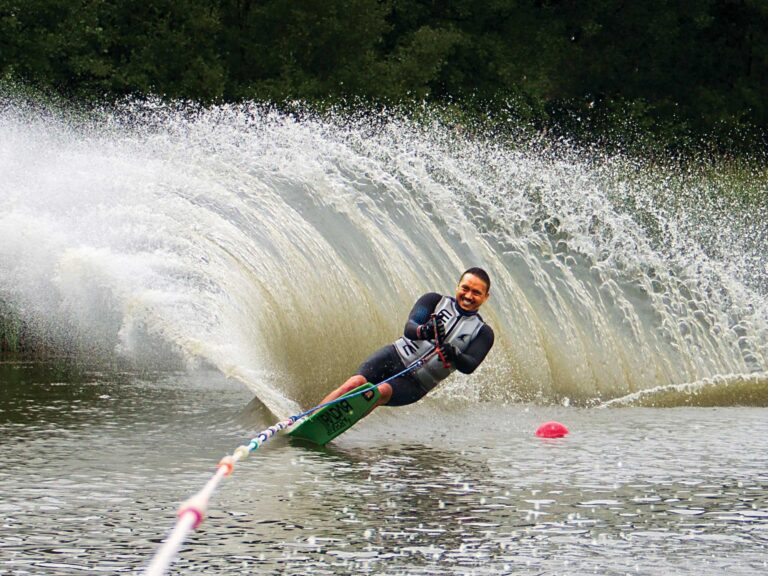
Take Your Tow-Sports Skills to the Next Level

- Digital Edition
- Customer Service
- Privacy Policy
- Terms of Use
- Cruising World
- Sailing World
- Salt Water Sportsman
- Sport Fishing
- Wakeboarding
Many products featured on this site were editorially chosen. Boating may receive financial compensation for products purchased through this site.
Copyright © 2024 Boating Firecrown . All rights reserved. Reproduction in whole or in part without permission is prohibited.

Catamarans for Rough Seas: What Makes Them Great
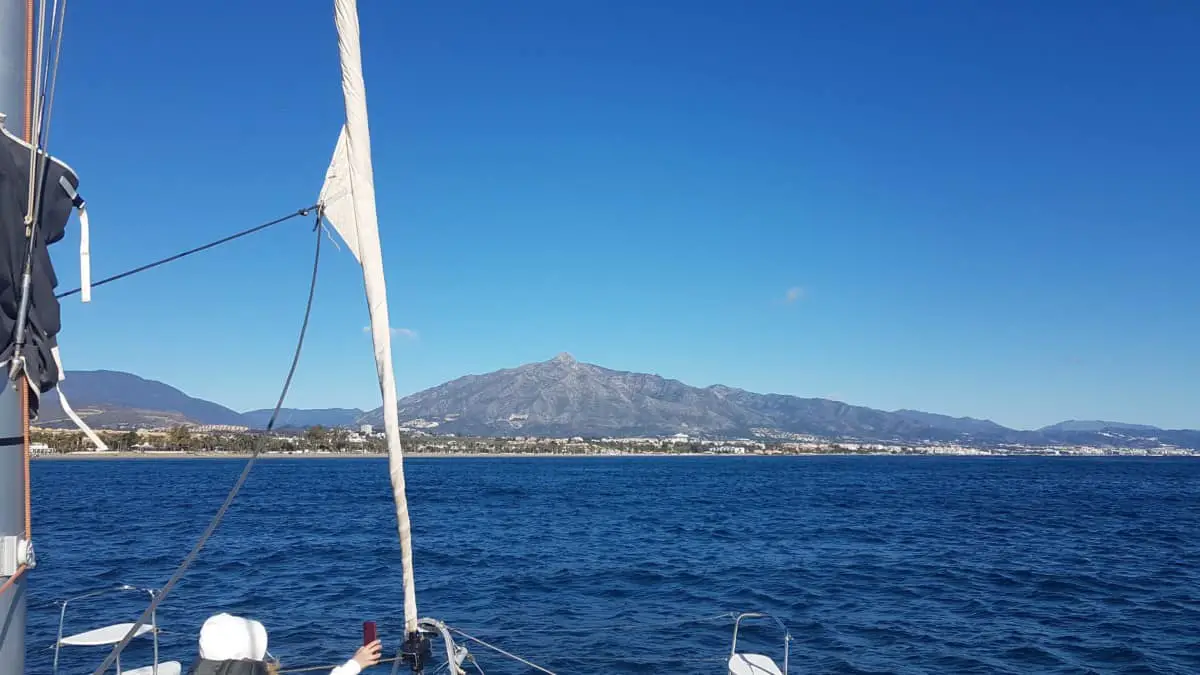
As an Amazon Associate, we earn from qualifying purchases. We may also earn commissions if you purchase products from other retailers after clicking on a link from our site.
Sailing a catamaran in rough seas is a whole different story from the comfortable, leisurely cruising with your friends and family. If your cat can’t take the pressure of high waves, things can get ugly fast. So, are catamarans good for rough seas, and which are the best ones?
Some of t he best catamarans for rough seas are Leopard 53, Magnum 46, Catana 53, Heliotrope 48, Lagoon 78, and 70 Sunreef. They all feature high performance to outrun heavy weather, have wide beams for added stability, low windage designs, and enough bridgedeck clearance to prevent pounding.
In this article, I’ll elaborate on the key features necessary for cats to handle rough seas and which ones are the best for taking on rough seas.
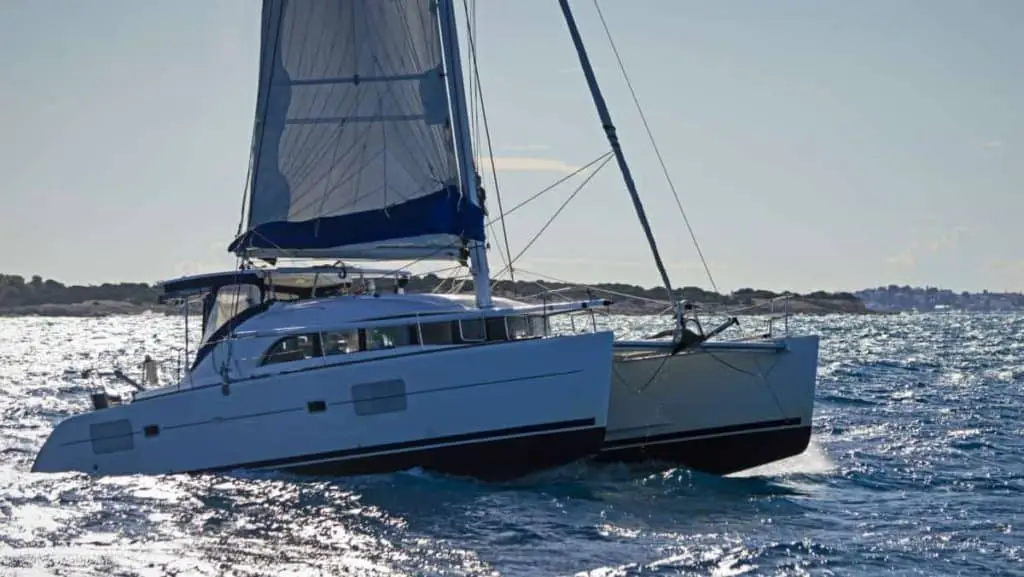
Table of Contents
A Common Myth Busted: Catamarans Aren’t Safe
There’s a myth among sailors (not cat sailors) that catamarans can’t handle rough seas because they’re designed for cruising or anchoring in shallow waters and will easily flip over. However, cats are, in many ways, safer than monohulls since they’re more stable, maneuverable, and faster due to having two hulls and two engines.
Plus, while both catamarans and monohulls can capsize, it’s easier for the latter to flip back over. However, multi-hulls are virtually unsinkable, making them safer in case of capsizing.
In addition, due to their high performance and lightweight, they’re faster than monohulls of the same length. This feature helps the sailor outrun any bad weather conditions and navigate the vessel to a safe place.
Features a Catamaran Needs to Handle Rough Seas
Not every cat is suitable to go to heavy seas, and before purchasing any boat, you should consider the necessary features that make it safe to use for offshore cruising, what specifications accommodate your cruising needs, and the price you’re spending.
Let’s take a look at the six critical features a catamaran needs to handle rough seas (blue water able) and how these features offer enhanced safety when sailing in unstable water conditions.
Daggerboards Help Prevent Sideways Slipping
A daggerboard is a retractable vertical keel put in the hull’s central part only seen in sailing boats. Since catamarans don’t have an adequate keel area, they need daggerboards to reduce leeward drift. The bigger the daggerboards are, the better the boat’s performance.
A boat without daggerboards has reduced pointing ability, more drag, less speed, and reduced safety. That’s why a daggerboard is one of the most crucial parts of a catamaran to sail to the wind.
Daggerboards boost the cat’s performance by preventing it from slipping to leeward and lifting the boat to windward. It works like an airplane wing, allowing you to operate the boat at higher upwind angles. This feature comes in handy in rough weather and high waves.
Deep Rudders For Better Offshore Steering Control
Rudders are parts of the boats in charge of steerage and directional stability. Since they’re essential for safe steerage, catamarans have twin rudders to provide more security and reduce the pressure on the helm (autopilot).
Because catamarans have a small draft, the rudders are sometimes more vulnerable to blows and impacts, especially in rough seas close to shore, where reefs and debris can be a problem. Longer, deeper rudders are more effective because they are stronger and more stable downwind.
Best Size Catamaran For Ocean Sailing and Rough Seas
The blue water catamaran’s length plays a major role in combating high winds. A longer cat can move easier, is more maneuverable, and naturally much heavier. Strong winds can toss about the boat easily, provided that its length is in a good proportion to other dimensions.
Most cat enthusiasts believe a minimum of 40 feet (12m) is optimal for a cat to survive in rough seas. As a general rule of thumb, the best length-width proportion is 45 to 22 feet (13.72 to 6.71 meters).
In addition to safety, a bigger boat will allow for more weight because it has more space, and you can arrange your gear in a more organized way. This also makes controlling them in emergencies much easier.
Enough Bridgedeck Clearance
Bridgedeck clearance refers to the space between the hulls. The bridgedeck height plays a crucial role in the cat’s ability to handle choppy seas in a comfortable and safe way. A high bridgedeck clearance gives waves enough headroom to flow between the hulls.
So, sailing in big waves causes slamming and pounding when there’s not enough bridgedeck clearance. The slamming can, in turn, lead to crew fatigue and loss of speed. Plus, it will lead to more wear and tear on the gear and equipment.
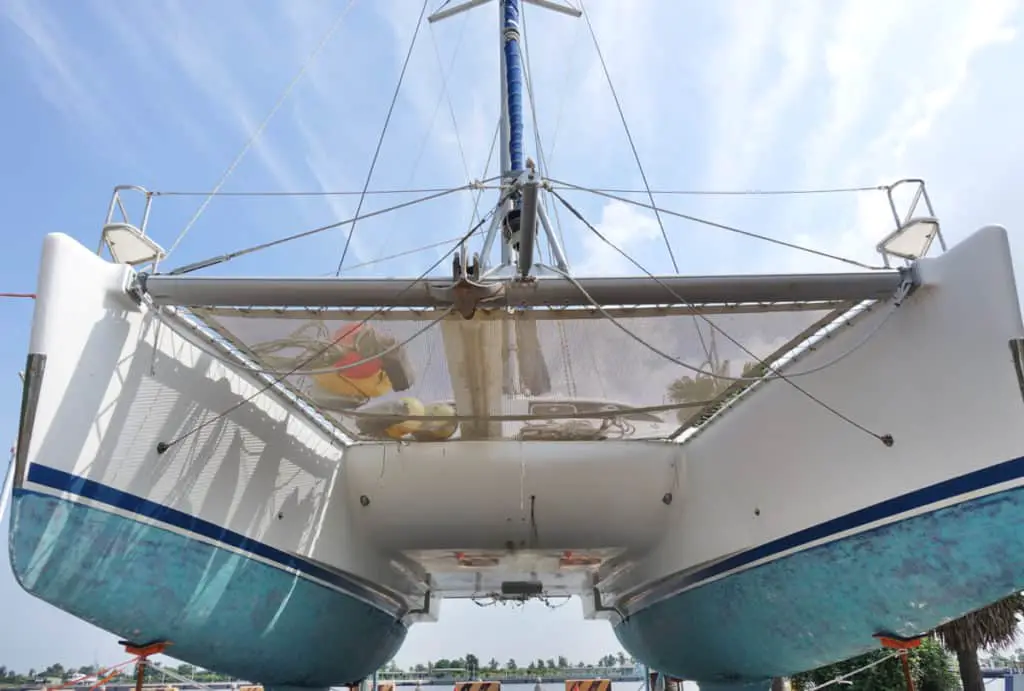
The bridgedeck clearance will be reduced when the boat is loaded heavy. So, the higher it is, the more freedom you have in loading your boat with gear, freshwater, and fuel (at least this is one aspect of the load-carrying capabilities). Although bridgedeck height is more of a comfort-related factor, the pounding under rough conditions can be stressful for both the boat and the crew.
The clearance should be between 5-6 percent of the catamaran’s LOA as a general rule of thumb. So, if the cat is 40ft (12m), the bridgedeck height should be around ~2ft (0.6m).
High Speed Get You to Safety Quicker
When at sea, you need to avoid dangerous conditions as much as possible. A high-speed catamaran helps you get out of the ugly situation faster. To avoid such bad conditions, you need to perform weather monitoring and smart routing.
A crucial factor that affects speed is displacement. Most modern cats have light displacement, leading to less hull drag and more speed.
Want to understand why catamarans are faster than monohulls I suggest you read two of my other articles:
- Why cats are so fast
- Catamaran hull speed calculator
- Why trimarans are faster than catamarans
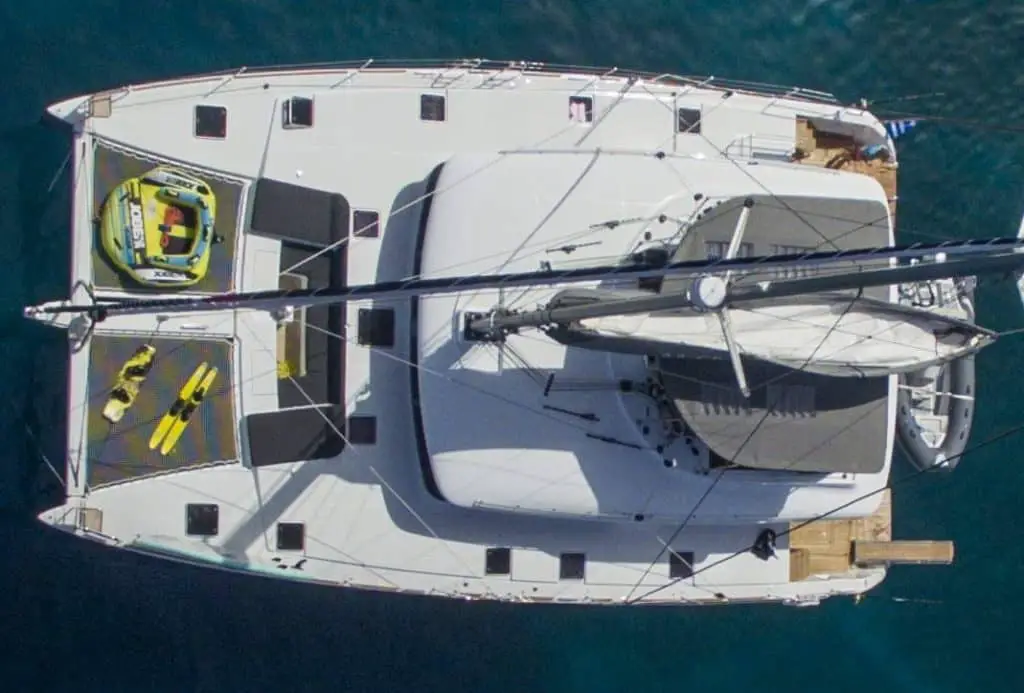
Wide Beam Adds Stability
One of the inherent advantages of catamarans is their stability compared to monohulls. So, no matter which cat you have, you can rest assured that it’s more stable due to its multi-hull structure, no more heeling.
Catamarans go through less rocking and rolling even in heavy seas, making the crew more comfortable and helping them deal with the situation better. Fatigue and even seasickness play an important role in the crew’s ability to control the vessel in rough conditions.
Unlike monohulls, catamarans don’t have ballast or lead-filled keels. So, their stability completely relies on their wide beam and buoyancy. A heavy-weight boat goes through the waves (lead-filled keel monohull) while a light vessel will go up and over (light displacement cat).
Improve Your Seamanship Before Tackling Rough Seas
The right cat that can navigate rough seas isn’t enough. You will also need the right seamanship and skillset, once you have acquired these skills you can navigate through any offshore situation.
If you don’t have enough knowledge and skills, you shouldn’t be careful of venturing out too far. You can educate yourself by taking courses or spending as much time sailing coastal waters as possible.
In addition to knowing how to sail, you should learn about different weather conditions and how to predict the weather as it changes.
You should also know how to take care of your crew and how to place your boat in the most comfortable and safest setup in high waves; know when to slow down or speed up and how to move with the sea.
Knowing how to calm down the cat by using the right amount of sail and proper angle is another key skill you should know before setting out blue waters.
Unlike the myth that cats can’t handle rough seas because they’re not safe enough, these vessels have proven to be stable and fast enough for any ocean!
Owner of CatamaranFreedom.com. A minimalist that has lived in a caravan in Sweden, 35ft Monohull in the Bahamas, and right now in his self-built Van. He just started the next adventure, to circumnavigate the world on a Catamaran!
Leave a Reply Cancel reply
Your email address will not be published. Required fields are marked *
Save my name and email in this browser for the next time I comment.
Recent Posts
Must-Have Boat Gear for Catamaran Sailors!
Sailing is probably the most gear-intensive activity I've ever done; there are so many decisions to be made about what gear to buy now, for tomorrow, and what to definitely never buy. The gear on...
6 Best Trailerable Trimarans For Bluewater and Coastal Sailing
Having a boat costs a lot of money, even when you are not using it, marina fees, etc. And once it is in the water most sailors never go very far from their "home marina" and sailing will be somewhat...
- 2024 BOAT BUYERS GUIDE
- SWS ADVENTURES
- Email Newsletters
- Fishing Boat Reviews
- Fly Fishing
- Marine Electronics
- Fishing Tackle
- Fishing Destinations
- The Bahamas Fishing Guide
- Boating Safety
- Ultimate Boat Giveaway

Boating Tips for Rough Seas
- By Capt. Dave Lear
- Updated: August 22, 2022
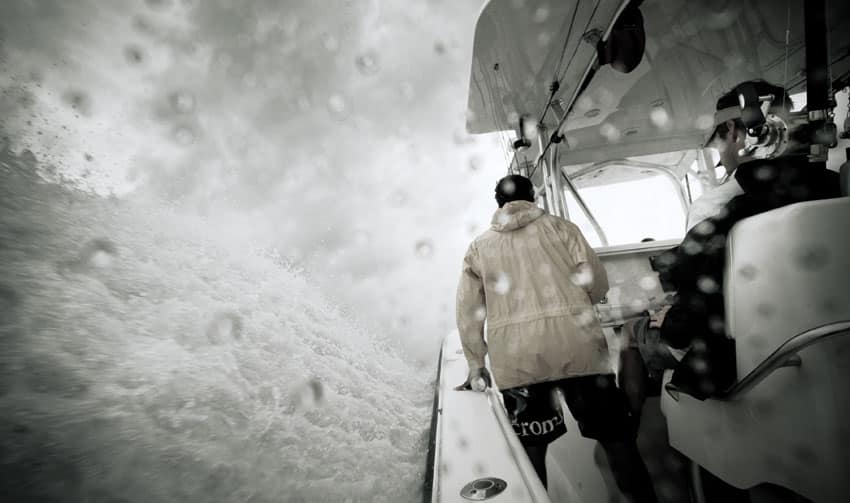
Unless you’ve got 50-plus feet of fiberglass underneath you, you’re not immune to stormy weather conditions. Run offshore this time of year and sooner or later you’re going to get caught in high winds, big seas or both. Large sport-fishing boats in rough seas have the length and beam to handle the slop. But small to mid-size vessels are at greater mercy. If you slow down and drive accordingly, potentially hazardous situations can be avoided for small boats in rough seas.
“In the summertime, sooner or later you’re going to have a big line of thunderstorms, 40-knot winds and 6- to 8-foot seas between you and the dock,” explains Marcus Kennedy, a tournament competitor on the Yamaha professional tour. “Novice boaters in rough water don’t realize that and they panic and don’t know what to do. But all it takes is common sense to drive a boat in rough water. If you tack like a sailboat with quartering waves off the bow or stern, you’ll have a better ride and make better time. Safety is always paramount.”
Kennedy, who fishes a Yellowfin 36 center console from Dauphin Island, Alabama, often makes long runs to find fish in adverse seas. During a recent out-of-town king mackerel event, he ran 100 miles down Florida’s Gulf Coast to take advantage of calmer nearshore water before angling out to the Dry Tortugas. The final southwest track let him run in a favorable trough.
How to Drive a Boat in Rough Water
“You want to plan your route to optimize the boat’s running angle with the sea conditions,” Kennedy says. “Avoid a dead-head or beam sea whenever you can because it’s nearly impossible to make any headway. During tournaments we partner with another boat and stay in sight or radio contact in case of emergencies. And you should always carry twice as much fuel as you think you’ll need. Boats in rough water and seas gulp the gas.”
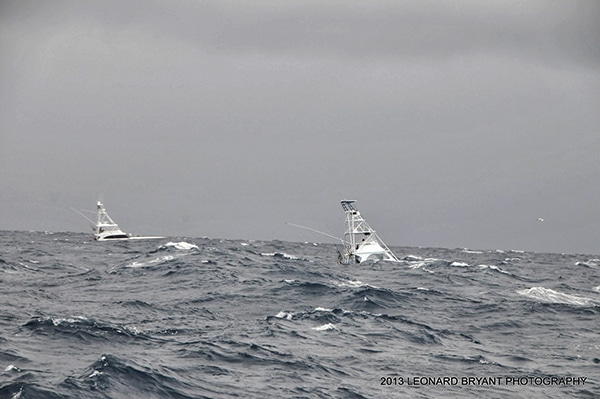
Capt. Frank Crescitelli, a New York charter captain and tournament contestant, faces similar conditions off the Atlantic seaboard during the summer months. A run from New Jersey’s Long Beach Island to the Hudson Canyon is 96 miles. Heading south to the Baltimore Canyon is a 92-mile leg, and Crescitelli often targets bluefin tuna out to 40 miles. And he recognizes the best path back to port is not always the one he took offshore.
“I never head out if I know I’ll have two rough rides,” he says. “Our prevailing summer wind is southwest and I can deal with that one way. But I always plan on the possibility of deviating from my course if necessary. I’d rather zigzag or return to a different port if it means a smoother, safer ride.” Crescitelli runs a Regulator 32 center-console for his offshore charters, and radar is an essential part of its onboard equipment.
“I check the forecast beforehand and constantly monitor the radar and Sirius weather during the day,” he says. “I avoid storms whenever possible. My radar has a 50-mile range, so that gives me plenty of time to react. But I always know the compass heading home in case we lose electronics or have electrical interference.
“One of the biggest mistakes people make is running directly for the dock whenever a storm blows up,” Crescitelli adds. “But sometimes it’s better just to ride it out. Most of these summer storms are fast moving, so if you make slow forward headway keeping the bow into the wind, it’ll often blow right by. Otherwise, it could follow you the whole way home and make for a long, miserable ride.”
Knowing your boat’s performance characteristics is also important in how to drive your boat in rough water, says Capt. Dan Stauffer, who runs charters out of Ocean City, Maryland, aboard a classic 31-foot Bertram with twin diesel engines. Stauffer says his hull handles predictably in rough seas yet is also relatively light for its size. He added 1,000 pounds of lead ballast to help keep the bow from porpoising.
“Two years ago we got caught in honest 10-footers,” he said. “I was standing on the bridge looking eye level at the waves. I’ve also been sandwiched between two storms when the straight-line winds were so strong it stalled the radar. But that doesn’t happen often, maybe only a dozen times a year out of 120 trips. If I can’t get around something, my first reaction is turn into the wind, slow down and idle until it moves on by.
How to Trim a Boat in Rough Water
“Some guys never even touch the trim tabs and that always makes me scratch my head,” he added. “It’s all about the tabs. If you tab down in a following sea with certain hulls, you can turn it into a submarine. With my boat, however, I add a little to get that bow down in a head sea so it’s chewing the waves. You have to know how your boat performs under different conditions, and tabs are the great equalizer.”
When Crescitelli encounters rough seas, he has his crew stay nestled in beanbags in the cockpit. He also carries a Winslow life raft aboard, and the emergency ditch bag is tied within reach at the leaning post.
“Don’t ever get into panic mode,” he says. “If you do, you’ll make bad decisions. Things have to be really bad to get out of a 32-footer and into an 8-foot life raft. So I’d rather slow down and safely surf the waves home in the boat, even if it takes more time.”
Safety and Boating Tips for Fishing Boats in Rough Seas
- Slow down. Slower speeds allow better reaction time. Adjust the throttle to ascend/descend waves to avoid taking on water.
- Use the trim tabs carefully. Too much down tab can force the bow into oncoming waves, while no tabs allow the hull to plane as designed.
- Keep an eye on the radar or satellite weather. It’s always easier to go around a storm than through one.
- Tack into the waves rather than take them head-on, if possible.
- Alter your course to take advantage of more favorable sea conditions.
- Carry plenty of fuel.
- Know the tides and locations of shoals before running an inlet.
- Wear a life jacket.
- File a float plan.
- More: Boating Skills , Boats , Center Consoles , How-To

Scout 357 LXF

Electric Outboard Steering

Best Dredge Fishing Tips for Center Consoles

EdgeWater 208CC Watchman

Where to Find the Best Fishing in August and September

Salt Water Sportsman’s Deals of the Week

Outstanding Trout and Redfishing in the Chandeleur Islands

- Digital Edition
- Customer Service
- Privacy Policy
- Terms of Use
- Cruising World
- Sailing World
- Salt Water Sportsman
- Sport Fishing
- Wakeboarding
Stay in the Loop: The latest cruise DEALS & NEWS delivered to your inbox - Click Here!
CruiseOverload
The 8 Roughest Seas For Cruise Ships (RANKED!)
Going on a cruise is the perfect combination of adventure and relaxation, a chance to explore the world from the decks of luxury.
However, traveling by sea comes with unpredictable moods and the possibility of rough seas. Modern cruise ships are engineered to withstand rough conditions, but knowing which seas are notoriously turbulent can help in planning your journey.
For those that are prone to seasickness or nervous about a rough voyage, there are certain seas they may want to avoid.
From the swirling currents of the North Atlantic to the icy gusts of the Southern Ocean, we’ll guide you through the roughest seas that even experienced cruise ships respect…
Table of Contents
Roughest Seas For Cruise Ships
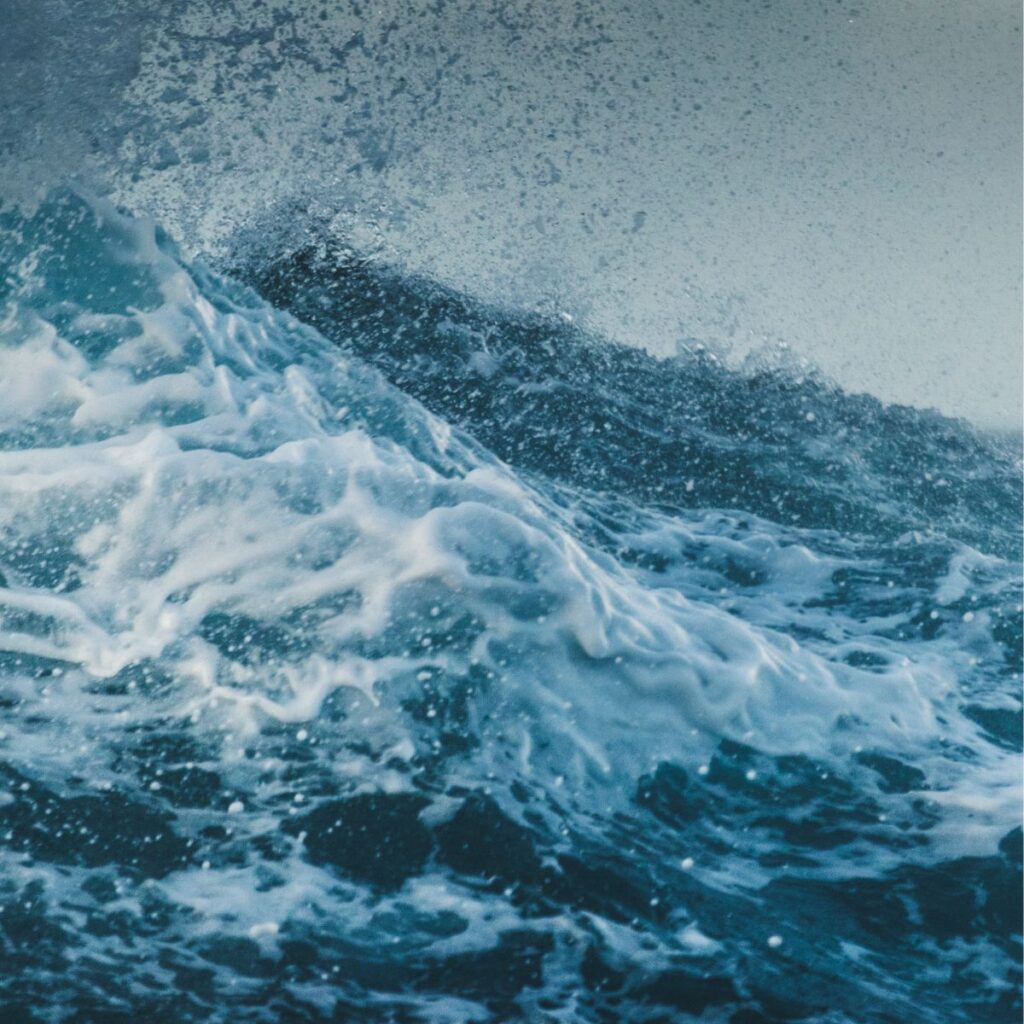
The Drake Passage
If you’re looking to cross off all seven continents, you’ll have to board an expedition ship to step foot on Antarctica, as mainstream cruise lines only traverse through the Drake Passage.
The Drake Passage is one of the roughest seas in the world, and it’s located between Cape Horn and the South Shetland Islands.
It’s the shortest crossing between Antarctica and the rest of the world, connecting the Atlantic and Pacific oceans.
The area has no large landmasses, so there is a large, unimpeded flow of current that carries a huge volume of water through the passage.
When these strong currents meet high wind speeds, the result is a sea state that is notoriously rough. This combination of factors contributes to conditions where it is quite likely for passengers to encounter rough seas in this area.
These challenging conditions are a defining characteristic of Cape Horn, making it one of the most hostile waters for sea travel.
The Bay of Biscay
If you plan to take a European cruise, you should approach the Bay of Biscay with caution.
The Bay of Biscay is located off the west coast of France and the north of Spain.
The Bay of Biscay is home to parts of the continental shelf that extend far into the bay, resulting in some shallow waters.
This is an area that experiences the fiercest Atlantic weather, and the combination of powerful winds and a shallow seabed can produce large waves.
Traveling during the summer months can significantly enhance your chances of encountering smoother seas.
On the other hand, opting for a late spring journey may bring you face-to-face with the unique “June Gloom” phenomenon. This is characterized by a vast fog triangle that often envelops the southern part of the bay.
This seasonal atmospheric condition, most prevalent in June, results in a dense fog that adds a mystical ambiance to the area, though it doesn’t typically affect sea conditions significantly.
Cruises that often sail through the Bay of Biscay include those sailing from Southampton to Portugal and Spain. Transatlantic voyages that begin in the UK and Northern Europe will often sail south and visit the Azores before beginning to cross the ocean, too.
When cruising through the Bay of Biscay, be prepared for rough seas and pack accordingly. It is recommended to bring motion sickness medication and warm clothing, as the weather can be unpredictable.
The Gulf of Alaska

If you’re heading on a cruise around Alaska, you will be pleased to hear that most of the cruise will be spent on the beautiful calm waters of the Inside Passage, where a string of islands will provide shelter and a high chance of smooth sailing.
But, if you are heading for ports at Seward, Whittier, or Anchorage, you will have to cross the Gulf of Alaska.
These waters are much rougher than the protected waters of the Inside Passage due to strong surface currents and cold air.
This is a much rougher area where strong surface currents and cold arctic air meet to generate powerful storms that affect British Columbia and the western U.S. Storms can happen at any time, but the worst time is between October and February.
Note: the vast majority of Alaska cruises take place within the sheltered waters of the Inside Passage. If you want to avoid cruising through the Gulf of Alaska, consider a round-trip cruise from Seattle.
However, cruises that do traverse through the Gulf of Alaska tend to visit more remote parts of Alaska, providing a unique and adventurous experience.
The Atlantic Ocean
Whenever you cross a large body of water, you’re more likely to encounter some rough waves since there’s no land nearby to provide any protection.
The Atlantic Ocean is no exception. Transatlantic cruises tend to see their roughest waters in November, December, and February.
If you’re going to embark on a transatlantic cruise in the winter, it’ll most likely be on either a luxury cruise line like Oceania or Cunard from New York to Southampton and vice versa.
While the winter months are the most intense, it’s important to note that other times of the year can also be impacted, particularly during hurricane season.
It’s always a good idea to keep an eye on the weather forecast and prepare accordingly.
If you’re concerned about rough waters, it’s best to stick to more protected areas of the Atlantic, such as the Caribbean or Mediterranean, where the waters are generally calmer.
The Mediterranean
If you’re looking to stay in the Mediterranean and visit culturally rich ports of call like Barcelona, Rome, Naples, then you’re in luck.
While the sea itself is relatively sheltered, It can be surprisingly rough, subject to rough waters in the fall and winter, as this is when the winds are the strongest.
Rough seas can happen at any time, though, and spring and summer cruise passengers might experience some rough seas.
Cruises in the Western Mediterranean, often embarking from ports like Barcelona or Rome, might encounter a unique weather phenomenon known as a “medicane.” This term, a blend of “Mediterranean” and “hurricane,” describes a rare but intense storm that shares characteristics with hurricanes and can impact this region.
These medicanes, though not as common as typical hurricanes, can still significantly influence sea conditions and cruise experiences in the Western Mediterranean.
This is a tropical storm that usually hits the region about once a year, most commonly in the autumn.
The Caribbean

The allure of the Caribbean as a cruising hotspot is undeniable, with its stunning beaches, crystal-clear waters, and inviting tropical cocktails. It’s a destination that appeals all year round, offering a blend of relaxation and scenic beauty.
Yet, it’s important to note that the region does experience its share of stormy weather, particularly during the hurricane season, which spans from June to November.
The likelihood of encountering hurricanes and tropical storms is highest from August to September.
If the idea of navigating through larger waves or facing potential changes in your cruise itinerary is less appealing, it might be wise to plan your trip outside these months.
Additionally, in the Caribbean, where different bodies of water converge, such as the meeting point of the Caribbean Sea and the Atlantic Ocean, there’s an increased likelihood of encountering rough seas, especially during the storm-prone months.
The South China Sea
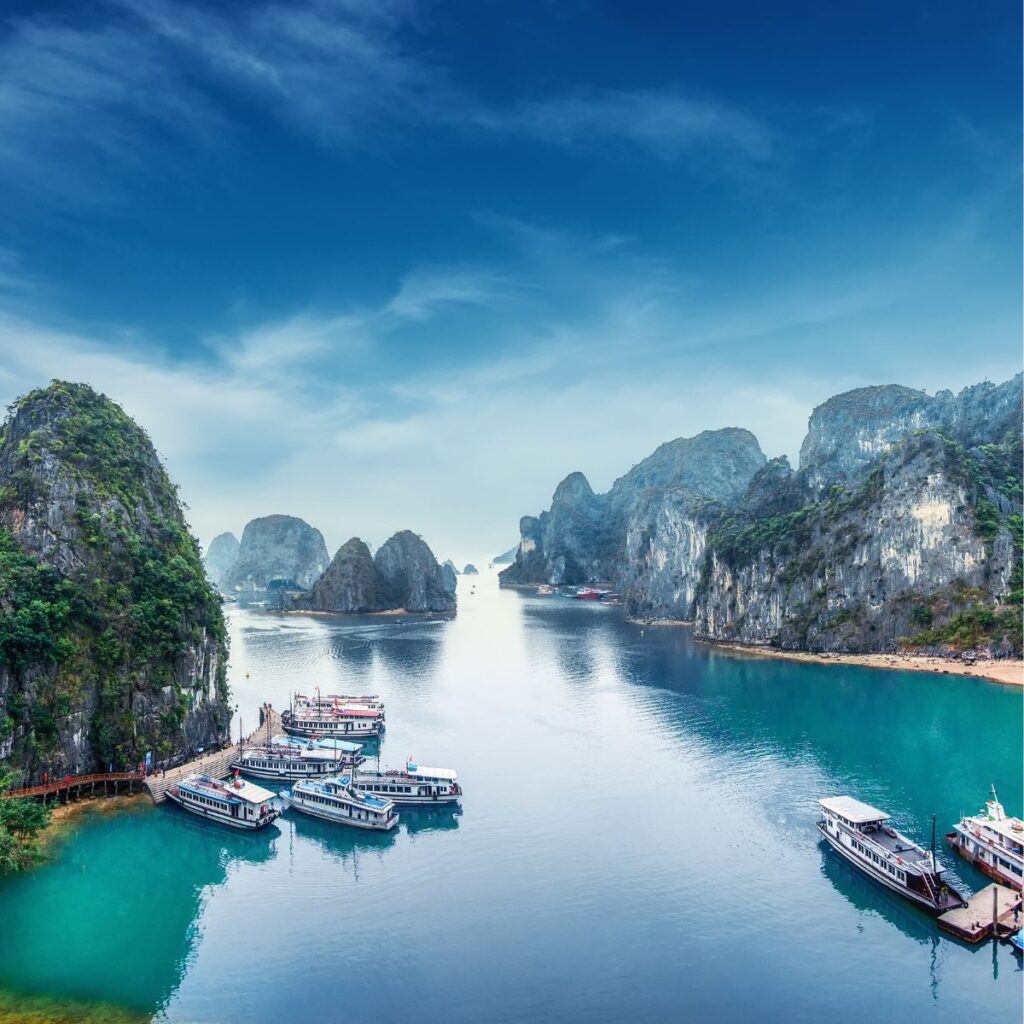
If you’re planning on taking an Asian cruise, you may be curious about the South China Sea.
This region is becoming increasingly popular for mainstream cruise lines, with Disney Cruise Line and Royal Caribbean both increasing their presence in Asia.
This area, part of the northwest Pacific Ocean, is known for its susceptibility to storms throughout the year, potentially leading to rough sea conditions.
Tropical typhoons and cyclones, most prevalent during the tropical storm season from July to November, are the primary causes of the biggest waves in this region. Storm activity tends to peak around late August and early September.
Key departure ports for cruises traversing this area include Singapore, along with other popular ports like Hong Kong, Shanghai, Beijing, and Bangkok. Routes connecting China to destinations such as Vietnam, Cambodia, or the Philippines are particularly prone to typhoons, which can result in a turbulent journey and possible changes to port stops.
On top of this, the South China Sea encompasses a region known as “The Dangerous Ground.” This area is infamous for its hidden dangers, including low-lying islands and submerged reefs that can emerge unexpectedly from the depths.
Due to its complex geography and historical territorial disputes, this zone is typically avoided in Asian cruise itineraries, regardless of the starting port. This precaution is taken to ensure a safer and smoother cruising experience in the often unpredictable waters of the South China Sea.
The North Sea
If you’re planning a cruise to North Europe, the British Isles, or even Iceland, you’ll likely have to pass through the North Sea.
Sailing through the North Sea can be quite challenging due to its susceptibility to high winds and waves, which often result in rough waters and thick fogs.
Traveling through the North Sea, especially from ports like Southampton to destinations such as Edinburgh, cruisers may encounter rough conditions.
The waters here can get particularly choppy, causing ships to experience significant rocking, akin to the sensations of a roller coaster.
While modern cruise ships are designed to handle these rough seas, passengers should be prepared for potential changes in their itineraries.
What Is Considered Rough Seas For A Cruise Ship?
Rough seas for a cruise ship are typically characterized by high winds and significant wave heights, which can lead to noticeable ship movement and discomfort for passengers.
Generally, waves exceeding 7-8 feet (about 2-2.5 meters) are considered rough, but modern cruise ships are designed to handle much higher waves safely.
The Beaufort Wind Scale, which categorizes wind speed, is often used to gauge sea conditions; rough seas are usually indicated by wind speeds over 17 knots (about 20 mph or 31 km/h).
These conditions can cause a cruise ship to pitch (move up and down) or roll (tilt side to side), leading to a more turbulent experience on board.
The perception of roughness can can vary among passengers, depending on their susceptibility to seasickness and the design and size of the ship. Larger, more modern cruise ships are equipped with stabilizers that significantly reduce the rolling motion, making them more resilient to rough seas.
Despite this, in extremely high seas with waves reaching over 15 feet (4.5 meters) or in the case of severe storms, even large ships might experience noticeable movement.
Cruise lines closely monitor weather conditions and may alter itineraries to avoid rough seas for passenger comfort and safety.
What Time Of Year Are Seas The Roughest?
The roughest seas typically occur during the transition between seasons, particularly in regions prone to cyclones or hurricanes.
In the Atlantic and Caribbean, for instance, the hurricane season peaks from August to October, bringing turbulent seas with higher risks of storms and rough conditions.
Similarly, in the Pacific, typhoon season, which typically lasts from May to October, can lead to rough seas, especially around Southeast Asia and the Western Pacific.
In contrast, the Southern Hemisphere experiences its roughest seas during its winter months, from June to August. This is especially true in areas like the Southern Ocean, where cruises to destinations like Antarctica are affected.
The Drake Passage, known for some of the world’s most challenging sailing conditions, sees its roughest waters during this period.
On top of this, areas like the North Sea and the Mediterranean can also experience rougher conditions during the winter months.
Are Cruise Ships Safe in Rough Seas?

Yes, cruise ships are safe in rough seas. They are designed to withstand waves up to 15 feet high, and they have stabilizers to reduce the amount of rocking felt onboard. However, you may still feel the motion of the waves, especially if they are particularly large.
If the captain deems it necessary, they may order passengers to stay indoors. It is also a good idea to stay seated and take medication for motion sickness if necessary.
In extreme weather conditions, such as encountering 30-foot waves, cruise ships like the Anthem of the Seas have successfully navigated through with no major issues or injuries to passengers or crew.
Are Seas Rough in the Caribbean?
The Caribbean, renowned for its typically calm cruising conditions, does encounter rougher seas under certain circumstances.
The Atlantic hurricane season, spanning from June to November, presents the highest likelihood of experiencing turbulent waters in the Caribbean, particularly in zones where the Caribbean Sea converges with the Atlantic Ocean.
Despite these seasonal challenges, major cruise lines continue to operate numerous voyages to the Caribbean throughout the hurricane season.
They often modify their sailing routes to circumvent the most severe storms, which means that cruise itineraries may be more prone to alterations during these months.
Are Seas Rough On A Transatlantic Cruise?
Seas on a transatlantic cruise can indeed be rough at times, primarily due to the vast and open nature of the Atlantic Ocean. The experience of rough seas on such a cruise largely depends on the time of year and the specific route taken.
For example, during the Atlantic hurricane season, which runs from June to November, there’s a higher chance of encountering rougher seas, particularly in the North Atlantic. This is due to the increased likelihood of storms and turbulent weather patterns.
Are Seas Rough Around Japan?
The seas around Japan can be rough at certain times of the year, influenced by the region’s specific climatic conditions. The most significant factor is the typhoon season, which typically runs from May to October.
During this period, the waters around Japan can become particularly turbulent due to the increased likelihood of typhoons and storms.
These weather events can lead to high waves and strong winds, creating challenging conditions for sea travel.
Are The Seas Rough Around Cape Horn?
The seas around Cape Horn, located at the southern tip of South America, are notorious for being some of the roughest in the world.
This reputation is largely due to the confluence of the Atlantic and Pacific Oceans in this region, combined with strong winds, large waves, and unpredictable weather patterns.
The area is known for its challenging sailing conditions, characterized by what sailors call the “Roaring Forties” and “Furious Fifties” — strong westerly winds found in the Southern Hemisphere, particularly between the latitudes of 40 and 50 degrees.
Similar Posts

Upside Down Pineapple Meaning On Cruise Ships (IYKYK!)

Choosing Your Cruise Cabin: Pros and Cons of Each Option (Find What’s Right for YOU!)

Can You Drink At 18 On A Cruise? (Drinking Ages Explained!)

How Fast Do Cruise Ships Go At Night?
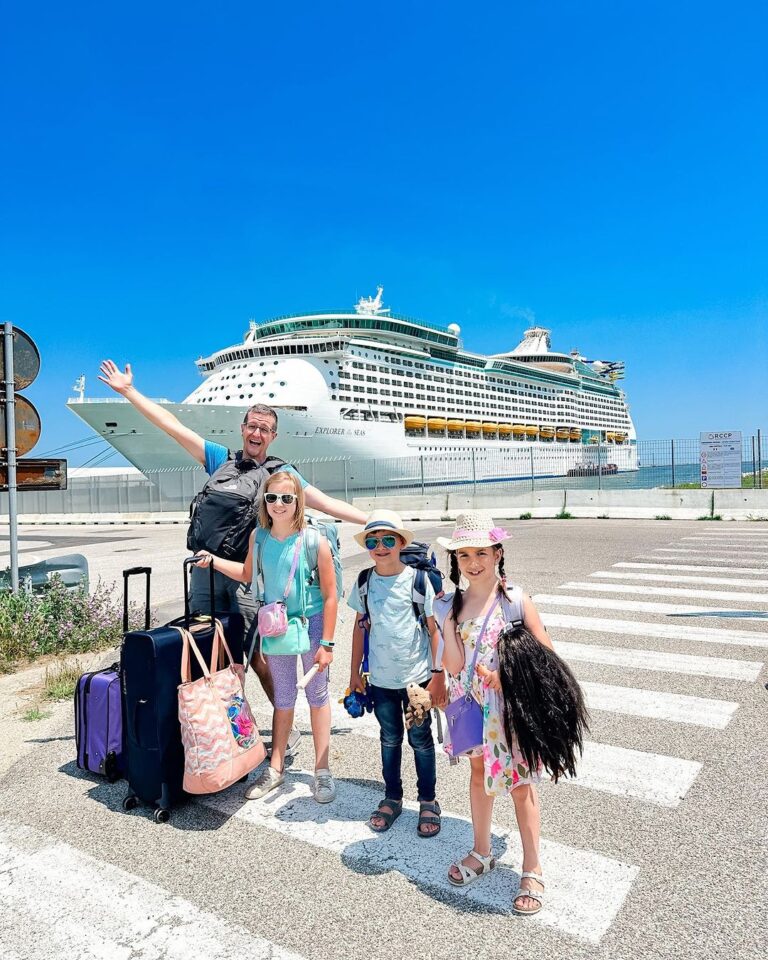
Cheapest Cruises for Families: Top 10 Budget-Friendly Lines with Kids Sail Free

Are There Cameras On Cruise Ship Balconies? (Privacy Concerns Answered!)
Leave a reply cancel reply.
Your email address will not be published. Required fields are marked *
Save my name, email, and website in this browser for the next time I comment.
Boat Reviews
- Boats Specs
- Marine Pros
- Boat Insurance
- Boat Warranties
- Boat Transport
- Boat Towing
- Marine Forecasts

Your Ultimate Boating Resource

Are sailboats safe in rough seas?
As a boating enthusiast, one of the concerns that many sailors and yachties have is whether sailboats are safe in rough seas. The truth is, sailboats can be safe in rough seas, but it largely depends on the vessel’s make, design, condition, and the skills of the crew.
Sailboats rely on the wind to power them through the water, and in rough seas, this can make them more challenging to handle than motorboats. However, sailboats typically have better stability and maneuverability than motorboats, which can make them more capable of withstanding rough conditions.
One of the most critical factors in determining the safety of a sailboat in rough seas is the vessel’s design. Sailboats that are optimized for speed may be less stable in high seas, whereas those built for cruising are generally more stable and able to handle rough conditions. Additionally, larger sailboats with deep drafts and a solid ballast are generally more stable and less prone to capsizing.
Another critical factor is the condition of the sailboat. Proper maintenance and regular checks of the vessel’s systems, such as rigging, sails, and hull, can help ensure that the sailboat is seaworthy and safe to navigate in rough seas.
Finally, the crew’s skills and experience are vital in determining the sailboat’s safety in rough seas. Crews who are skilled at handling sailboats in challenging conditions and are well-versed in seamanship and navigation are more likely to be able to manage the vessel safely in rough seas.
Sailboats can be safe in rough seas, but it largely depends on the vessel’s make, design, condition, and the skills of the crew. As with any boating activity, it is essential to prioritize safety, proper maintenance, and be aware of the sea conditions to ensure a safe and enjoyable boating experience.
Related Questions
What type of wood is used for pier pilings, what is the difference between a dock and a floating pier, what is the proper technique for pulling a beginner wakeboarder, what does ‘no wake’ mean on a lake, what is the difference between wash and wake, is wakesurfing possible in the sea, why don’t wooden piers rot, what size wakeboard is needed, how to achieve more pop on a wakeboard, does wake surfing translate to ocean surfing, latest posts, overview of the 2024 sea-doo rxp-x 325, overview of the 2024 parker offshore 2900 cc, what your boat’s beam is and why it matters, power cats of 2024: ultimate guide to the top power catamarans this year, don't miss, our newsletter.
Get the latest boating tips, fishing resources and featured products in your email from BoatingWorld.com!
Navigating the Heat: 10 Safety Tips for a Safe Boat Ride in the Summer Heat
Highs, lows, and tidal know-how: a deep dive into ocean currents, 10 essential tips for fishing near private property, the benefits of using a drift sock: guidance for anglers, lure fishing: secrets for imitating live bait and attracting fish, explore the untapped depths of america’s best bass fishing spots, outboard motor maintenance: tips for keeping your engine in top shape, the essential boat tool kit: tools every boater needs, diy boat building: 8 tips and tricks for building your own vessel, the art of miniature maritime craftsmanship: ship in a bottle, antifouling paints: a guide to keeping your boat shipshape, beginner’s guide to standup paddle boarding: tips and techniques, boating for fitness: how to stay active on the water, kayak safety: how to stay safe on the water, anchoring in a kayak or canoe: how to secure your small boat, overview of the 2024 yamaha 252sd, overview of the 2024 tiara yachts 48 le, overview of the 2024 bass cat jaguar sts, 2024 pursuit os 445: an overview, 2024 aquila 47 molokai review, 2024 sea-doo switch 13 sport review, gear reviews, megabass oneten max lbo jerkbait review, fortress anchors fx-7 anchoring system review, fortress anchors fx-11 anchoring system review, fortress anchors commando anchor kit review, fortress anchors aluminum anchors review, stay in touch.
To be updated with all the latest news, offers and special announcements.
- Privacy Policy
East Hampton launches new patrol vessel for rescues, rough seas

East Hampton's 31-foot marine patrol vessel glided through Gardiners Bay at 40 knots on a recent summer afternoon, ready to monitor nearly 70 miles of shoreline.
Joe Vish, an 11-year veteran of East Hampton Town's Marine Patrol, sat at the helm of the department's newest vessel. Compared with the nearly 40-year-old boat it replaced, the new boat was a "night and day" difference, Vish, an East Hampton harbor master, said. The successor — East Hampton Marine 1 — has a superior design and layout and handles better in rough seas.
The boat also features forward-looking infrared radar to aid in night rescues. Its layout provides more room for passengers, and the enclosed cabin contains windows with 360-degree views, officials said.
"The way that this boat’s hull is designed, it’s leap years ahead," Vish said.
East Hampton's new patrol vessel
- The new vessel, East Hampton Marine 1, cost $476,000.
The town used $200,000 from the American Rescue Plan Act, a federal bill designed to help offset the economic impact of the COVID-19 pandemic. The town borrowed to pay for the rest.
- In a typical year, marine patrols respond to more than 1,000 calls that can vary from disabled vessels and distressed swimmers to shellfish violations and beach patrols.
Town officials are now operating a custom-made, $476,000 boat they say will enhance their maritime resources. Used for search-and-rescue operations as well as routine patrols, the Life Proof-designed boat adds new capabilities, officials said. It launched in July.
In a typical year, marine patrols respond to more than 1,000 calls that can vary from disabled vessels and distressed swimmers to illegal clamming. In 2023, the marine patrol conducted nine search-and-rescue operations, according to the department's most recent annual report.
"In times of emergency, every second counts, and this boat will significantly enhance our ability to respond quickly and effectively," Supervisor Kathee Burke-Gonzalez said in a statement.
Stabilizing collar
The vessel's collar — a foam-filled flotation device that encircles the boat — was a key selling point, said Tim Treadwell, East Hampton's senior harbor master. It allows the boat to easily come alongside another vessel and helps to stabilize the vessel in rough conditions.
The boat, like its predecessor, is also named for Sgt. Ryan P. Lynch, an East Hampton police officer who died from cancer in 2005.
The boat's arrival in early July came nearly a year after the town board voted to authorize its purchase from Inventech Marine Solutions, the company that manufactures Life Proof Boats.
The town used $200,000 from the American Rescue Plan Act, a federal bill designed to help offset the economic impact of the COVID-19 pandemic. The town borrowed to pay for the rest.
The newest vessel docks along Three Mile Harbor where marine patrol keeps a second, smaller boat. The department also has a station in Montauk, where its largest vessel, a 42-foot aluminum boat, is docked.
The department works closely with neighboring law enforcement agencies, the U.S. Coast Guard and East Hampton Volunteer Ocean Rescue, which responds to rescue calls for distressed swimmers.
Treadwell said officials have responded to seven search-and-rescue calls in the new boat's first month of operation.
In a recent incident, marine officers rescued two people stranded at night in Gardiners Bay on a small paddle craft.
'Christmas morning' experience
In neighboring Southampton Town, the police department's marine patrol deploys up to eight boats to respond to rescues in the ocean, bays and shallow waters. The department most recently acquired a 25-foot Silver Ship in 2016 to use in Shinnecock Bay and the Atlantic Ocean, according to Richard Franks, the department's senior marine patrol officer.
In 2017, Silver Ships delivered a 38-foot fire boat to Montauk as part of a collaboration that included the Montauk Fire Department, East Hampton Town and the U.S. Department of Homeland Security.
To narrow down the type of boat the harbor masters wanted, Treadwell said they consulted with law enforcement agencies.
Treadwell and fellow harbor master Jason Charron traveled to Seattle where Life Proof is based and took part in a "sea trial."
In the choppy waves off the coast of Bremerton, Washington, the new boat easily handled speeds of more than 30 knots, Treadwell recalled.
In that moment, he knew the vessel was right for East Hampton.
"That was the Christmas morning experience," he said.

Joe Werkmeister covers the towns of Southampton, East Hampton and Shelter Island. He is a graduate of St. Bonaventure University and previously worked as the editor of two North Fork community newspapers.

'I can't imagine what these young victims suffer' The mother of a Long Island sex-trafficking victim said Suffolk's new human trafficking court will offer the kind of lifeline that might have helped save her daughter. NewsdayTV's Shari Einhorn reports.
Get more on these and other NewsdayTV stories
Stay logged in.
The Newsday app makes it easier to access content without having to log in.
Unlimited Digital Access Only 25¢ for 5 months

COMMENTS
#heavyweather #sailingbeaver #beneteauoceanisJOIN OUR PATREON TEAM - For extra content, our eBooks, real-time updates, sea stories & more. https://www.patreo...
1. Prout Snowgoose 37: This is a real blue water cruising boat that is perfect for experienced multi-hull sailors who have cruised across the Atlantic. It is also a great option for those who are new to sailing on rough seas. 2. Moore 24: Designed by the legendary California sailor and surfer George Olson, the Moore 24 is one of the first ultra-light displacement sailboats.
Hallberg Rassy are known for being heavy, sturdy, seaworthy boats. This video shows Hallberg Rassy 48 Elysium in heavy weather off Cape Gris Nez, northern France in 2014. The yacht seems to be ...
Here's day two through five of our Atlantic Ocean sail from Bermuda to Charleston. Check out the sunsets, horrific squalls, knock-downs, high winds, and what...
In rough seas, the galley becomes a battlefield. The pitch and yaw of rough seas and gusty winds can turn a dutch oven into a scud missile. Things like glass jars and wine glasses soon become shrapnel as objects fling themself out of cupboards and smash on bulkheads and cabin floors.
Sailing in rough seas can be a daunting and challenging experience, even for the most seasoned sailors. The unpredictability of the ocean, combined with the potential for dangerous weather conditions, can make for a nerve-wracking journey. However, with the right preparation, knowledge, and mindset, you can overcome these challenges and safely ...
Here are six potential conditions you could encounter in rough seas: Head sea: A sea that is broad on the bow, coming at an angle between the bow and amidships. Broad sea: A sea coming at you between the bow and amidships. Beam sea: A sea coming at a right angle to the keel of your boat. Quartering sea: A sea coming at an angle between amidships and astern.
http://www.apvisuals.org/Sailing in rough seas in the gulf of Mexico during a voyage from St. Petersburg to Destin, FL. A front hit us from the west 3 days i...
Rough seas are defined as waves that rise to heights between 2 to 6 feet (0.6 -1.8 meters). ... Sailing in rough seas is a true test of seamanship. I used to be afraid of the seas, now it has become my friend. Maybe it will be the same for you! Take care! Inspiration. Gabo. Owner of CatamaranFreedom.com. A minimalist that has lived in a caravan ...
Specifically, most cats are happy and safe sailing at 6-7 degrees of heel as measured in flat water, or on the trough of a wave. As the boat approaches 10 degrees of heel, the windward hull will be close to lifting. It is safe to say that a cat should not lift its weather hull while on a cruising passage!
The best boat hull for rough seas must be able to handle following seas. "If you're going to have fine forward sections, you'll balance the hull by putting a lot of deadrise aft," Peters explained. "You're looking for recovery, a bow that doesn't plunge and that can regain its buoyancy in a following sea.
Best Size Catamaran For Ocean Sailing and Rough Seas. The blue water catamaran's length plays a major role in combating high winds. A longer cat can move easier, is more maneuverable, and naturally much heavier. Strong winds can toss about the boat easily, provided that its length is in a good proportion to other dimensions. ...
Alter your course to take advantage of more favorable sea conditions. Carry plenty of fuel. Know the tides and locations of shoals before running an inlet. Wear a life jacket. File a float plan. More:, , , Boating in rough seas offshore can be dangerous and deadly. Follow these helpful tips to get home safely back to your home port.
Browse 987 authentic sailboat rough seas stock videos, stock footage, and video clips available in a variety of formats and sizes to fit your needs, or explore sailboat storm or sailboat race stock videos to discover the perfect clip for your project.
Sailing through the North Sea can be quite challenging due to its susceptibility to high winds and waves, which often result in rough waters and thick fogs. ... Are Seas Rough Around Japan? The seas around Japan can be rough at certain times of the year, influenced by the region's specific climatic conditions. The most significant factor is ...
We suddenly had to sail back to Tahiti without a chance to wait for the perfect weather. Unforgettable and crew endured rough seas on this passage. As they ...
Browse 1,102 authentic sailing rough seas stock photos, high-res images, and pictures, or explore additional climbing or sailboat stock images to find the right photo at the right size and resolution for your project.
They can make excellent rough-water boats if properly designed, with much of the solidity and comfort of the displacement hull but also a good run of speed, often into the high 20- or low 30-knot range. ... The planing hull also tends to be drier in rough seas. The chine flats and spray strakes forward deflect spray down and out, the higher ...
Another critical factor is the condition of the sailboat. Proper maintenance and regular checks of the vessel's systems, such as rigging, sails, and hull, can help ensure that the sailboat is seaworthy and safe to navigate in rough seas. Finally, the crew's skills and experience are vital in determining the sailboat's safety in rough seas.
Go to our sponsor https://betterhelp.com/delos for 10% off your first month of therapy with BetterHelp and get matched with a therapist who will listen and h...
A planing boat cannot be successfully run like a displacement boat down-sea. The displacement hull is greatly limited in speed, but the very shape that limits its speed also helps keep it out of trouble in severe conditions. The stern sections of the displacement hull are fine, so they pick up buoyancy gradually.
A deeper draft also helps keep the boat stable in rough seas. The small cruising sailboat ought to be able to heave-to easily in a storm when the crew is tired and it's not as safe to be on deck. The rudder should be protected from debris, so it's a good idea to choose a skeg rudder or a full keel. The cabin needs to be well-designed with ...
The successor — East Hampton Marine 1 — has a superior design and layout and handles better in rough seas. The boat also features forward-looking infrared radar to aid in night rescues. Its ...
HOW TO DRIVE A BOAT IN ROUGH SEAS - BIG OCEAN SWELLS!We are so excited we finally had the perfect weather day to film this video! This has been a pretty cons...